Step-by-Step Guide to Building a $10k/Month Digital Business
Learn how to build a sustainable $10k/month digital business with this step-by-step guide. Discover strategies for starting, validating, scaling, and automating your side hustle while minimizing risks

Framework for Building a $10k/Month Digital Business - Overview

1. Start a Side Hustle While Working Full-Time
- Goal: Use your current job to learn new skills and validate your interests while earning a steady income.
- Execution: Don’t quit your job prematurely. A steady income allows for experimenting without pressure. Look for roles that offer skill development, mentorship, and exposure to business or industry insights.
- Example in Action: Working full-time while dedicating evenings or weekends to your business idea. Test the waters without risking financial security.
- Case Study Insight: The playbook creator spent nine months on Twitter, posting consistently before seeing results. The 30-day challenge helped refine skills and understand audience preferences, culminating in viral success on Day 28. This shows the importance of patience, consistent action, and sticking to one platform until you master it.
2. Validate Your Business Idea
- Goal: Start small with a low-risk product to gauge interest.
- Execution: Use social media or other channels to share ideas and gauge reactions. This can help determine what resonates with your audience and what they’re willing to pay for.
- Product Test Strategy: Begin with a low-priced product (e.g., $29 Notion library) and measure demand. If it performs well, it signals interest in related offerings.
- Case Study Insight: Initial sales of the Notion library validated the demand for productivity and content creation tools. Later, a $5k ghostwriting client was secured, validating demand for a higher-value service.
3. Differentiate Input vs. Output Thinking
- Goal: Shift from trading time for money to leveraging expertise and assets.
- Execution: Reflect on actions that yield results. Identify the 20% of activities driving 80% of outcomes (Pareto Principle) and focus on those.
- Optimize Offerings: Scale efforts by creating assets (e.g., courses, templates) that can generate income without directly trading time.
- Case Study Insight: By analyzing what attracted the $5k client (content and threads), the creator realized that building an online writing course could scale more effectively. This led to the creation of "Ship 30 for 30," a 30-day writing challenge for aspiring writers, which solved a specific problem for a niche audience in a repeatable, scalable way.
4. Niche Down Your Offer
- Goal: Build a focused, niche offer targeting a specific audience and solving a clear problem.
- Execution: Develop a product or service that addresses:
- One specific problem
- For one specific audience
- Through one specific solution
- Example Product: A 30-day writing challenge for beginner writers. This addresses a unique need with a guided, step-by-step approach, appealing directly to individuals wanting to build an online writing habit.
- Case Study Insight: Focusing on beginner writers who want to improve online writing skills allowed the creator to develop a flagship program. This clear, singular focus avoided diluting efforts across multiple services, leading to sustainable growth.
5. Reinvest in Yourself
- Goal: Fuel growth by investing in education, networking, and mentorship.
- Execution: Dedicate a portion of profits to reinvesting in knowledge, whether through masterminds, courses, or professional development.
- Example: Joining a high-ticket mastermind to accelerate growth and broaden one’s professional network.
- Case Study Insight: A $68k mastermind investment brought 5x ROI by providing valuable insights, connections, and strategies. This investment enabled scaling into the Premium Ghostwriting Academy, providing long-term growth and credibility in the ghostwriting field.
Why This Framework Works
- Minimized Risk: By starting while employed, there’s a safety net, making it easier to take calculated risks.
- Iterative Validation: Testing ideas on social media or other platforms ensures demand exists before investing heavily.
- Focused Scaling: Building one flagship product for a specific audience simplifies scaling and boosts revenue.
- Continuous Learning: Reinvesting in personal growth accelerates expertise and helps avoid stagnation, opening doors for new opportunities.
- Leveraging Digital Assets: Digital products and services can be scaled repeatedly without direct, incremental labor.
Putting It into Practice
- Identify a Skill or Knowledge Area You Can Monetize: Choose something that aligns with your interests and experience.
- Use Social Proof and Feedback Loops: Regularly engage with your audience for feedback to refine your product.
- Automate and Scale: As your revenue grows, invest in systems (e.g., email marketing, sales funnels) to automate parts of your business.
- Expand and Diversify: Once the main product is profitable, consider adding complementary offerings or premium tiers.
Framework Summary
This framework provides a strategic path to grow a side hustle into a sustainable, scalable digital business. It emphasizes starting small, validating ideas, focusing on a niche, and investing in continuous learning. By following these steps, aspiring digital entrepreneurs can gradually build a business that grows organically into a significant income stream.
1. Introduction to Building a $10k/Month Digital Business
1.1. Overview of the $10k/Month Digital Business Framework
Building a digital business with the potential to generate $10,000 a month requires a strategic blend of preparation, validation, focus, and consistent growth. Unlike traditional business models that often rely on significant upfront investment, this framework is designed for digital entrepreneurs who want to minimize risk while scaling a side hustle into a sustainable income stream. This method enables aspiring entrepreneurs to leverage digital tools, low-cost product testing, and a focused niche to create a scalable online business.
The framework emphasizes starting small with a manageable side hustle, then gradually building toward substantial income. From validating ideas in a low-risk environment to crafting niche offerings and reinvesting in personal growth, this approach guides entrepreneurs through each essential step of building a profitable digital business.

1.2. Key Benefits of Building a Digital Business Alongside a Full-Time Job
Many individuals hesitate to start a business due to the fear of financial instability, but beginning a digital venture while employed offers unique advantages. Balancing a side hustle alongside full-time work provides a steady income stream, allowing entrepreneurs to test ideas without the pressure of immediate profitability. This method significantly reduces the stress and risk often associated with business ownership, enabling a gradual transition to self-employment if desired.
Benefits include:
- Financial Security: With a stable paycheck, entrepreneurs can experiment without worrying about covering basic expenses.
- Skill Development: Many jobs provide valuable industry insights, connections, and mentorship opportunities that can accelerate business growth.
- Reduced Pressure on Decision-Making: Without the immediate need for profitability, business owners can make more informed, patient decisions that foster sustainable growth.

1.3. Why This Framework Minimizes Risk and Maximizes Growth
Starting a digital business based on a structured framework allows for calculated, low-risk steps. By validating ideas through low-cost digital products, entrepreneurs can confirm market interest before committing significant resources. This "test small, scale later" approach helps reduce financial risks and allows businesses to grow organically, aligning offerings with proven audience demand.
Framework advantages include:
- Incremental Scaling: By starting with small, low-cost products, entrepreneurs can gauge customer interest without overextending resources.
- Risk Mitigation: This approach minimizes exposure to financial loss by building a customer base and refining offerings in a gradual, manageable way.
- Focus on Profitability: With each step validated and profitable, business growth aligns directly with customer needs, creating a steady path to a sustainable income.
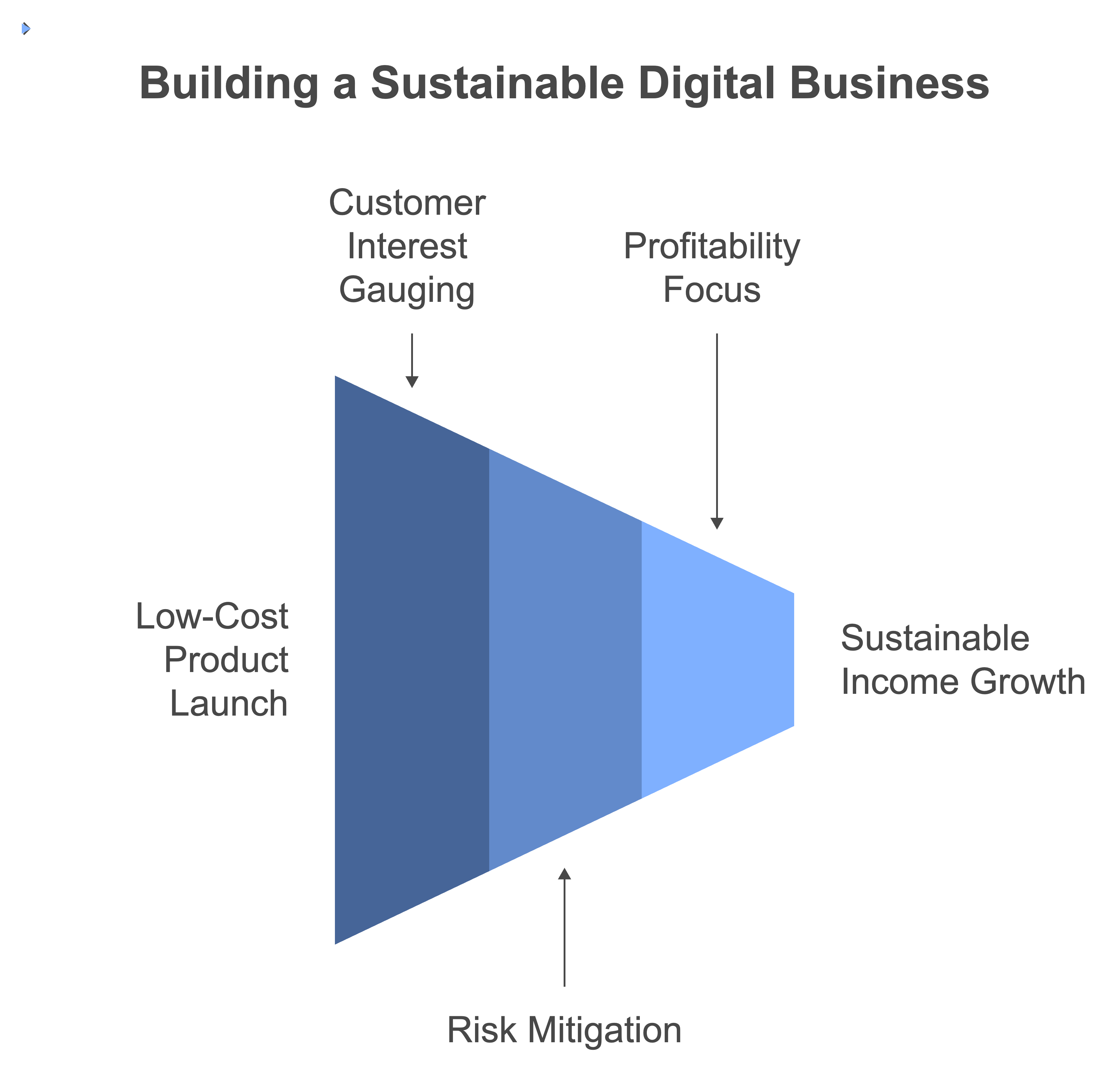
1.4. What Readers Will Learn from This Guide
This guide will equip aspiring digital entrepreneurs with the foundational steps to grow a $10k/month business. From selecting the right niche to understanding the importance of reinvestment and scalability, each chapter breaks down the framework into actionable, step-by-step guidance. By following this structured approach, readers will gain the tools to launch, validate, and scale a side hustle with confidence, ultimately building a sustainable digital business that aligns with both their skills and financial goals.
Key topics covered include:
- Identifying a profitable side hustle that complements full-time work
- Testing and validating digital product ideas to confirm demand
- Transitioning from time-based income to scalable assets
- Developing a niche offer that appeals to a specific audience
- Strategic reinvestment in growth, education, and networking
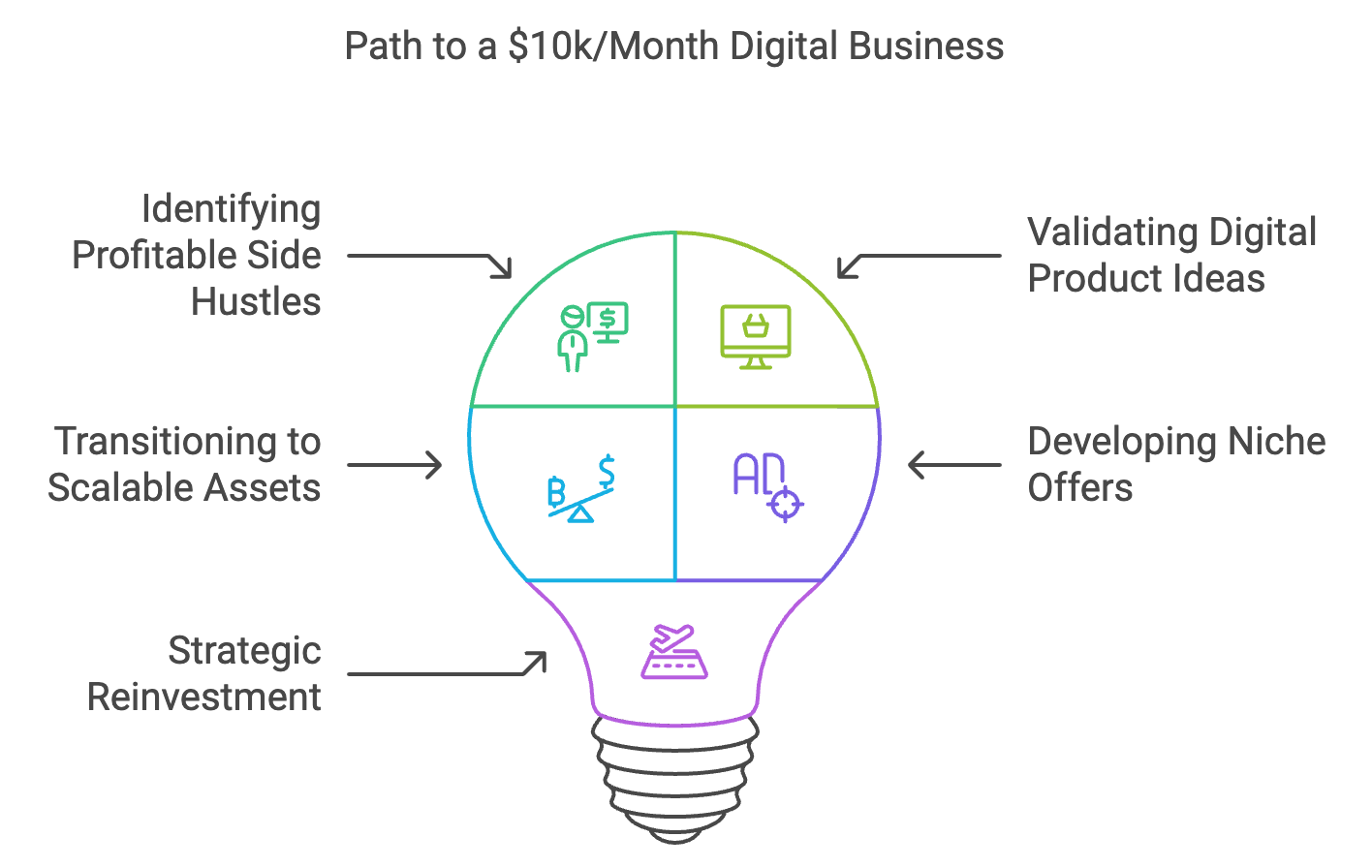
This framework offers a clear roadmap for those who seek to establish a successful digital business on their terms, balancing financial security with the freedom to grow and adapt their entrepreneurial vision.
2. Start a Side Hustle While Working Full-Time
2.1. Understanding the Role of Your Full-Time Job in Building a Side Business
Building a side hustle while employed full-time can be the ideal pathway to financial independence. Rather than abandoning a steady income, leveraging your current job as a foundation provides critical stability and resources. By maintaining your role, you can test business ideas without financial strain, access valuable industry insights, and even apply skills learned on the job to your side business.

2.2. Skill Development and Mentorship Opportunities Within a Full-Time Job
Many professionals overlook the opportunity to use their day job to build skills that directly support a digital business. Whether it’s project management, marketing, communication, or sales, most roles offer unique opportunities for growth and mentorship. By strategically seeking out projects or responsibilities that develop these skills, you prepare yourself with the tools needed for your business.
Key Areas to Focus on:
- Project Management: Learn how to organize, prioritize, and execute projects effectively, a crucial skill for managing a side hustle alongside a job.
- Sales and Negotiation: Many jobs involve customer interaction or negotiation, which can directly enhance your ability to sell your products or services.
- Digital Marketing: Look for opportunities to develop skills in content creation, social media strategy, or SEO, all of which are invaluable for digital business growth.
- Networking and Mentorship: Seek mentorship within your organization or industry. A mentor can provide guidance, advice, and introductions that can fuel your business development.
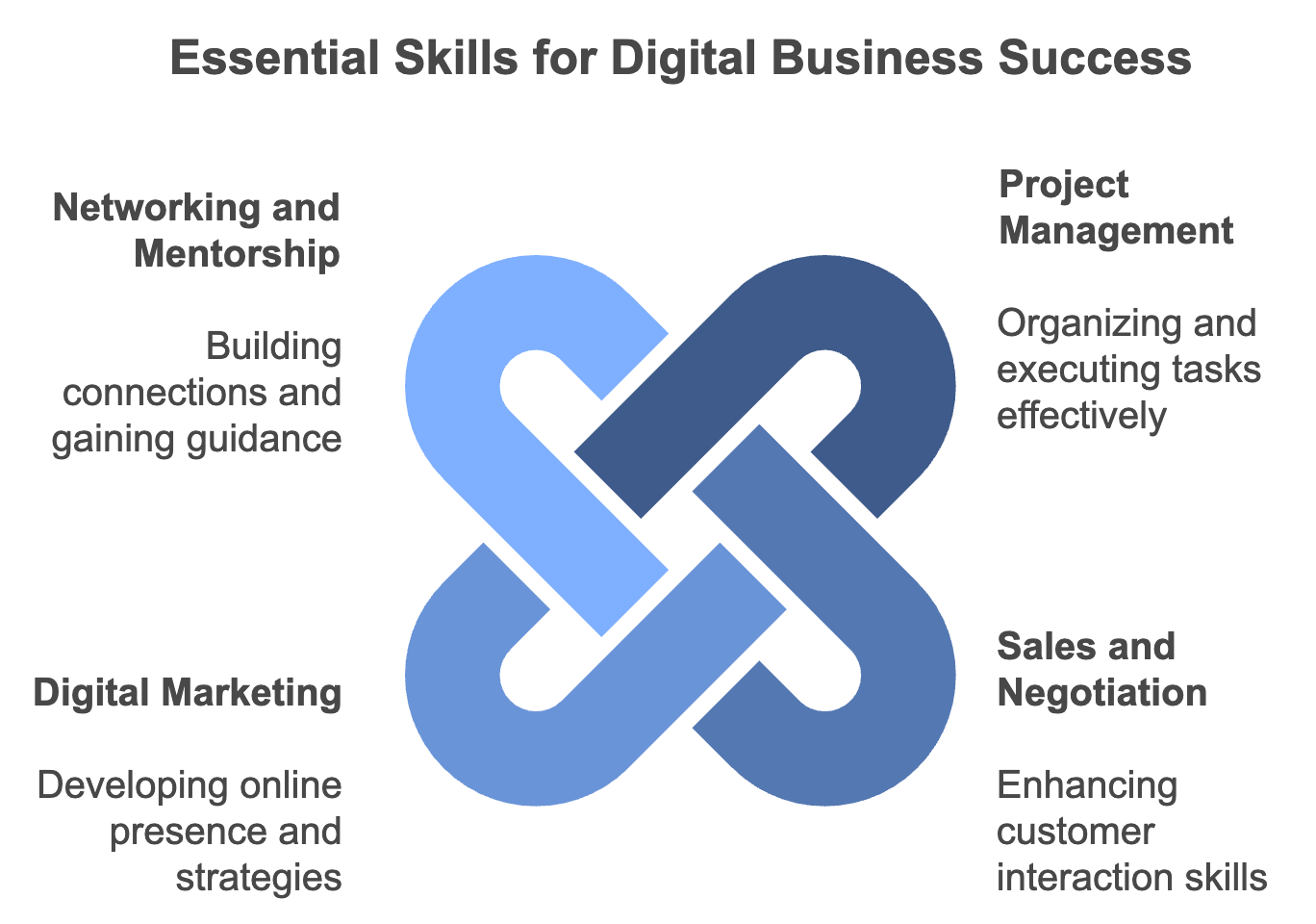
2.3. How to Dedicate Time and Energy Effectively to a Side Hustle
Balancing a full-time job with a growing side hustle requires discipline, efficient time management, and clear priorities. Without structure, it’s easy to experience burnout or fail to make progress on either front. Establish a schedule that allows you to dedicate focused time to your business without detracting from your work responsibilities.
Strategies for Effective Time Management:
- Set Dedicated Work Blocks: Allocate specific times in the evenings or weekends to work on your side hustle. Consistency builds momentum and maintains a healthy work-life balance.
- Prioritize High-Impact Tasks: Focus on the 20% of activities that drive 80% of results (Pareto Principle). Eliminate unnecessary or time-consuming tasks that don’t contribute to your goals.
- Leverage Tools for Efficiency: Utilize project management tools, time-tracking apps, and productivity hacks (like batching tasks) to streamline operations and minimize time spent on routine activities.
- Outsource Where Possible: As revenue grows, consider outsourcing tasks that consume time but aren’t critical to your growth, such as administrative tasks or basic graphic design.
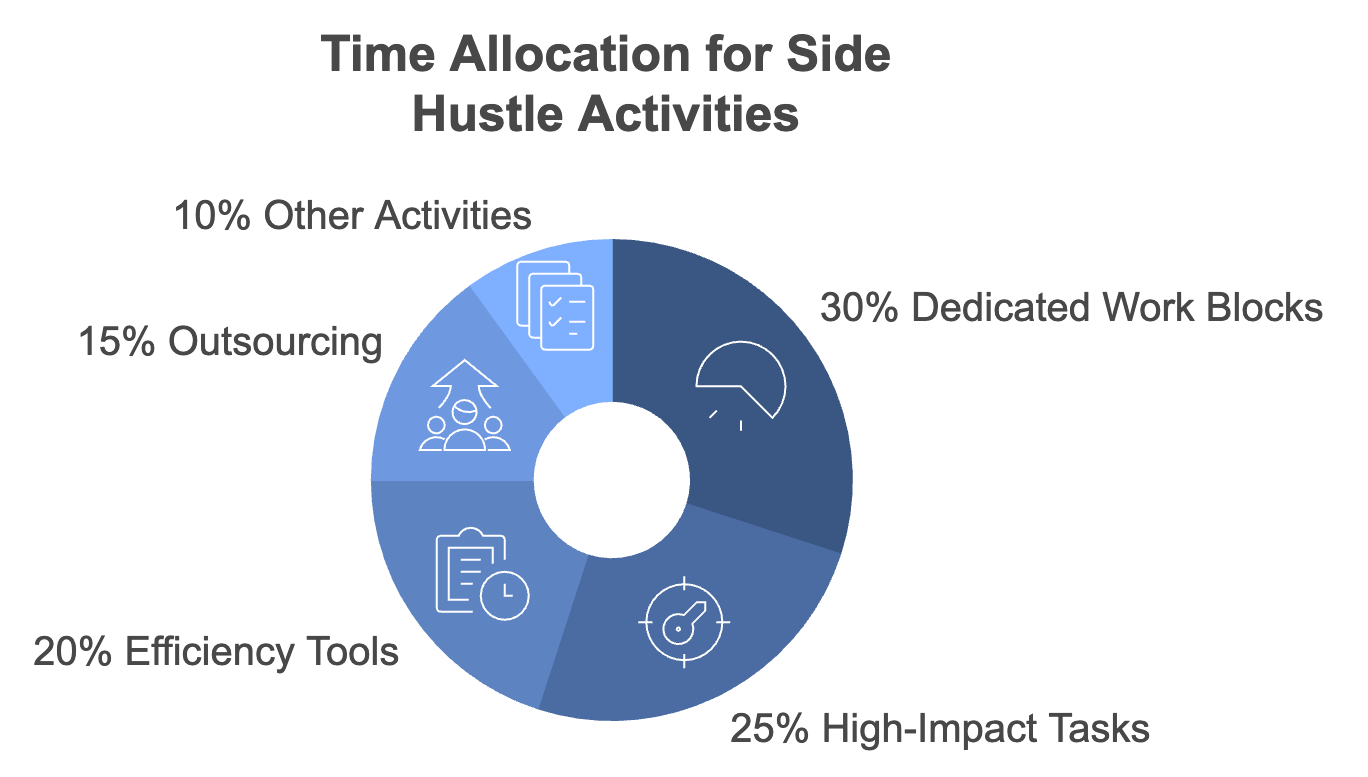
2.4. Case Study Insight: Leveraging Consistent Action on One Platform
Consistency on a single platform is key to building an audience and gaining traction, especially while balancing a full-time job. By focusing on one platform, you can concentrate your efforts, develop expertise, and build a loyal following without spreading yourself too thin.
Example of Consistency in Action:
A creator committed to posting daily on Twitter, dedicating just 30 minutes each day to crafting and sharing insights. Over nine months, this strategy resulted in a significant following, culminating in a viral post on Day 28 of a 30-day challenge. This rapid growth led to direct business inquiries and monetization opportunities, showing the power of consistent, targeted effort.
Lessons Learned:
- Patience Pays Off: Growth on digital platforms is often slow at first. Sticking to a consistent schedule, even with minimal immediate results, builds credibility and visibility over time.
- Mastery Through Repetition: Repeating specific actions on one platform allows you to understand what resonates with your audience and refine your approach.
- Platform-Specific Success: Focusing on a single platform reduces the risk of burnout and allows you to build a deep understanding of what works within that ecosystem, ultimately leading to higher engagement and conversion rates.
3. Validating Your Business Idea
3.1. Introduction to Low-Risk Product Validation
Validating a business idea is a crucial step in confirming that your target audience is interested in your offering before you invest significant resources. By adopting a low-risk approach, you can minimize potential losses and gain essential feedback, ensuring your product resonates with real market needs. This method involves starting with a small, manageable offering—like a low-priced digital product—allowing you to gauge interest, collect insights, and refine your concept.
Benefits of low-risk validation:
- Reduced Financial Exposure: Avoids large upfront investments in untested ideas.
- Immediate Customer Feedback: Early feedback helps in refining the product based on user needs.
- Increased Confidence for Scaling: Provides data-driven insights that signal when to move forward with confidence.
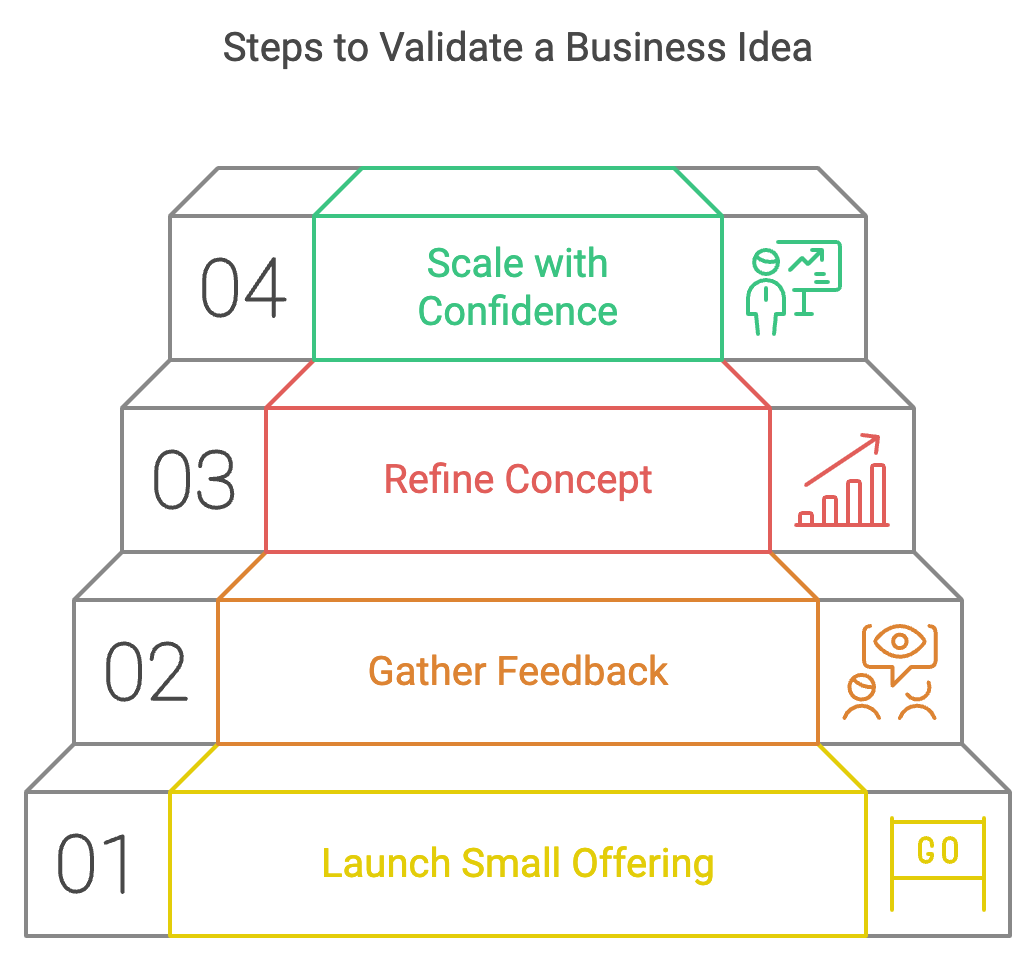
3.2. Methods for Testing Product Interest and Market Demand
Several methods can help you measure demand and determine if your business idea has potential. Most of these approaches leverage social media, content creation, and feedback mechanisms to quickly reach and assess your audience.
Social Media Polls and Feedback
Social media platforms offer powerful, immediate ways to test interest in your product idea. Polls on Instagram, Twitter, or LinkedIn allow followers to respond quickly, providing instant feedback. These platforms are also ideal for generating engagement, allowing you to assess not just interest but potential willingness to purchase.
Steps for effective social media feedback:
- Pose a Direct Question or Poll: Ask about pain points, preferences, or directly gauge interest in your idea.
- Analyze Comments and Engagements: Look at likes, shares, and comments to understand which aspects resonate.
- Refine Based on Feedback: Incorporate insights to make your product more relevant to audience needs.
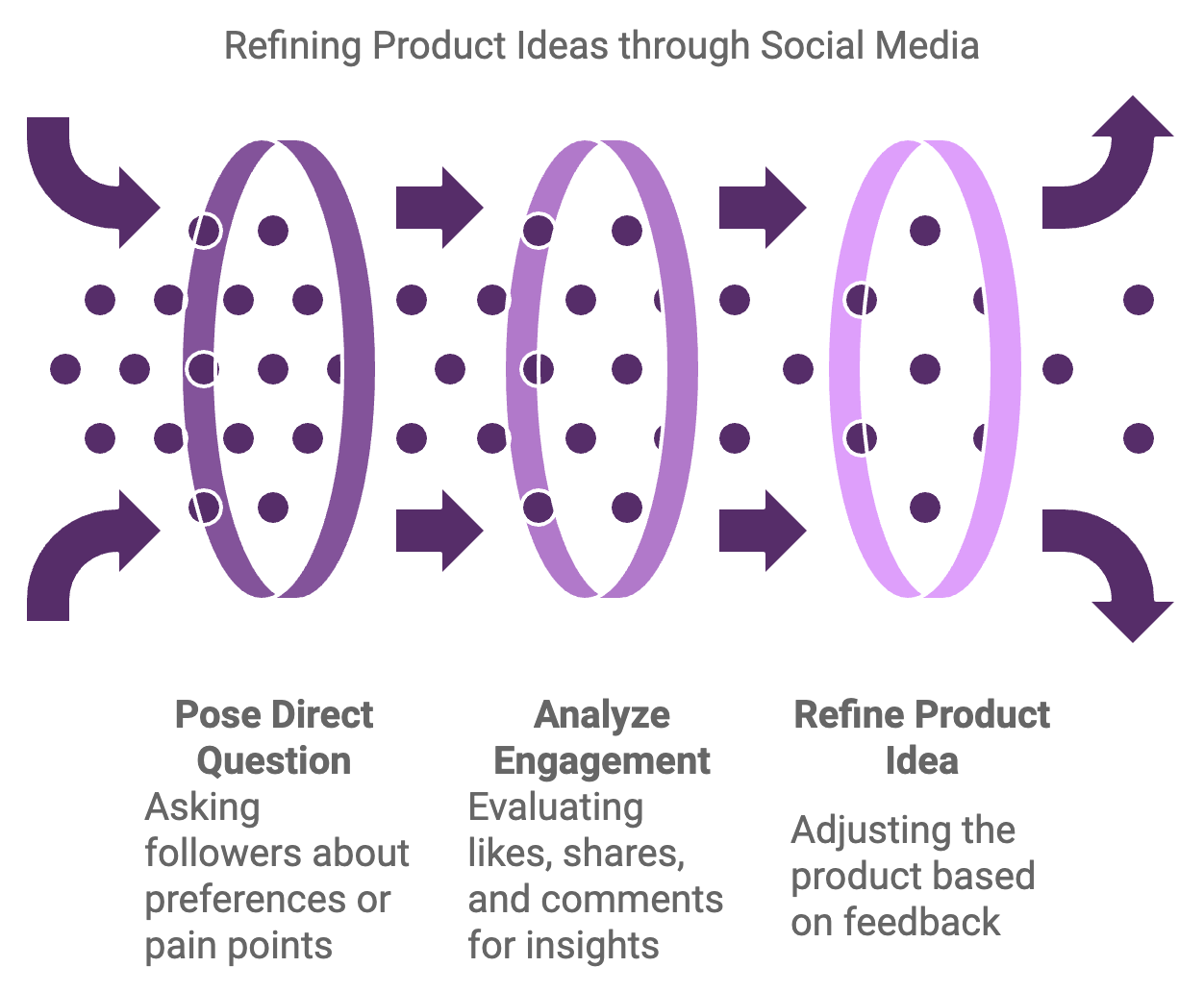
Content Testing on Platforms
Publishing content related to your product on platforms like Medium, LinkedIn, or Twitter can serve as a valuable testing ground. By writing articles or threads that address the problem your product solves, you can gauge interest based on reader engagement and interactions. High engagement indicates interest, while low engagement may signal a need for refinement.
Advantages of content testing:
- Direct Audience Interaction: Immediate responses help validate assumptions.
- Topic Relevance Insights: Tracks audience interest in specific aspects of your idea.
- SEO and Visibility Benefits: Positions your idea in front of a broader audience, attracting new potential customers.
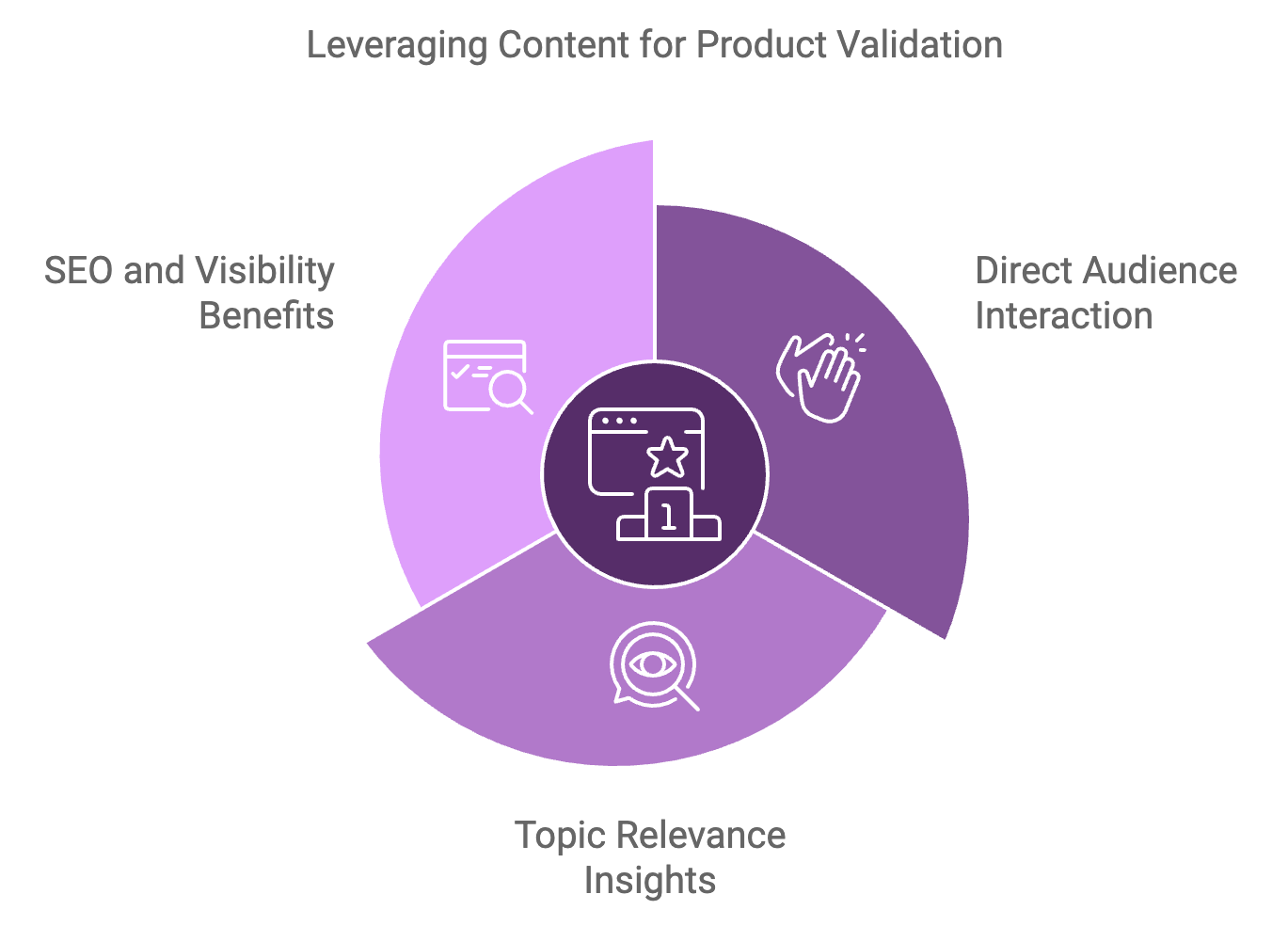
3.3. Strategies for Launching a Low-Cost Product to Test Demand
Starting with a low-cost product allows you to validate demand with minimal risk, while also generating initial revenue. Digital products, such as e-books, templates, or resources priced between $10 and $30, make excellent initial offerings, as they are low-risk for customers and easy for you to create and distribute.
Key Steps to a Successful Low-Cost Launch
- Identify a Pain Point: Focus on a specific problem your product can solve for a clearly defined audience.
- Create a Simple, Valuable Product: Keep it straightforward—such as a guide, template, or toolkit that addresses the pain point effectively.
- Market with Clarity: Use social media, email lists, and communities to introduce the product, highlighting the specific benefits and transformation it offers.
- Analyze Sales and Feedback: Track purchases, read reviews, and use customer feedback to determine whether the product meets demand or needs adjustments.
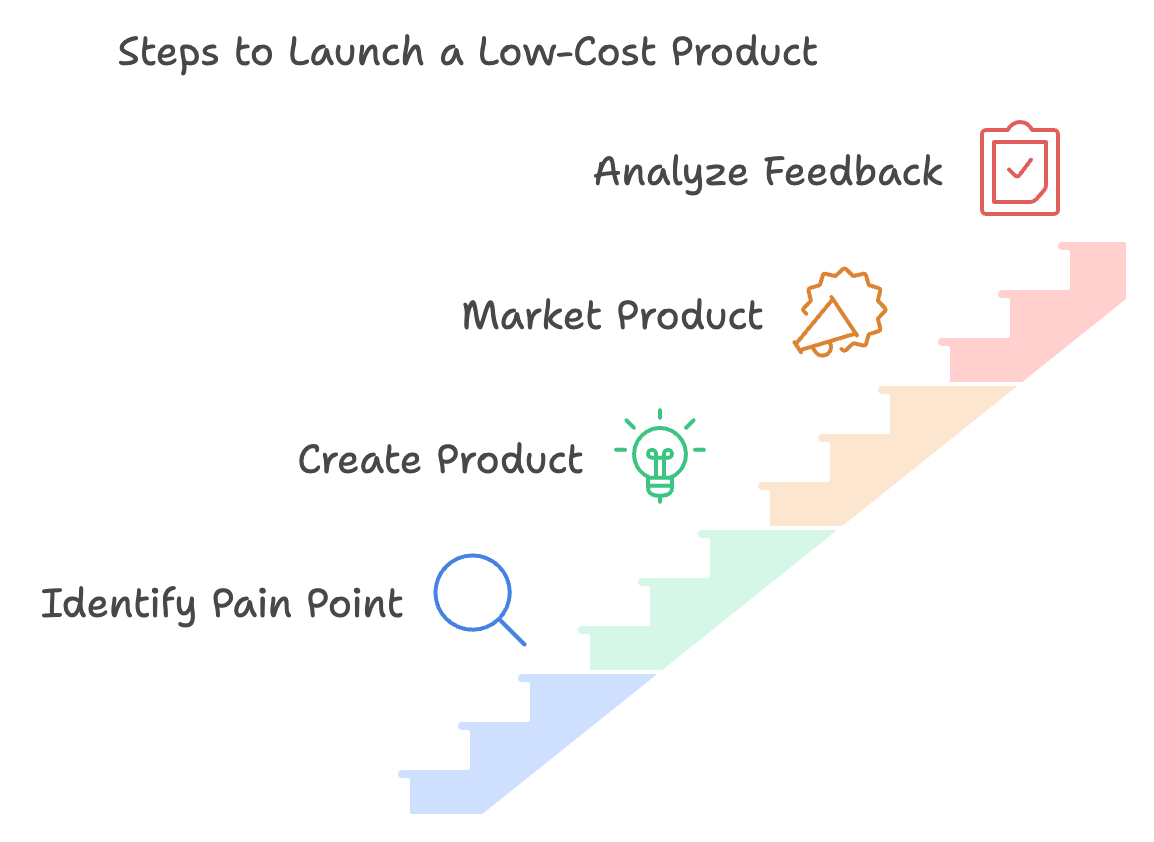
3.4. Scaling Based on Initial Success: Moving from Low-Cost Products to Premium Services
If your low-cost product gains traction, it indicates genuine market interest. This success provides a foundation to introduce higher-value offerings, such as premium products, consulting services, or personalized solutions. Building upon validated demand not only reduces risk but also enables confident scaling.
Steps for Scaling:
- Create Upsell Opportunities: Offer complementary or premium versions of the initial product (e.g., a full course or advanced guide).
- Refine and Expand Marketing Efforts: Broaden your reach through targeted ads, partnerships, or email marketing, leveraging insights from early customer data.
- Leverage Social Proof: Display testimonials, reviews, and success stories from initial customers to increase credibility and trust.
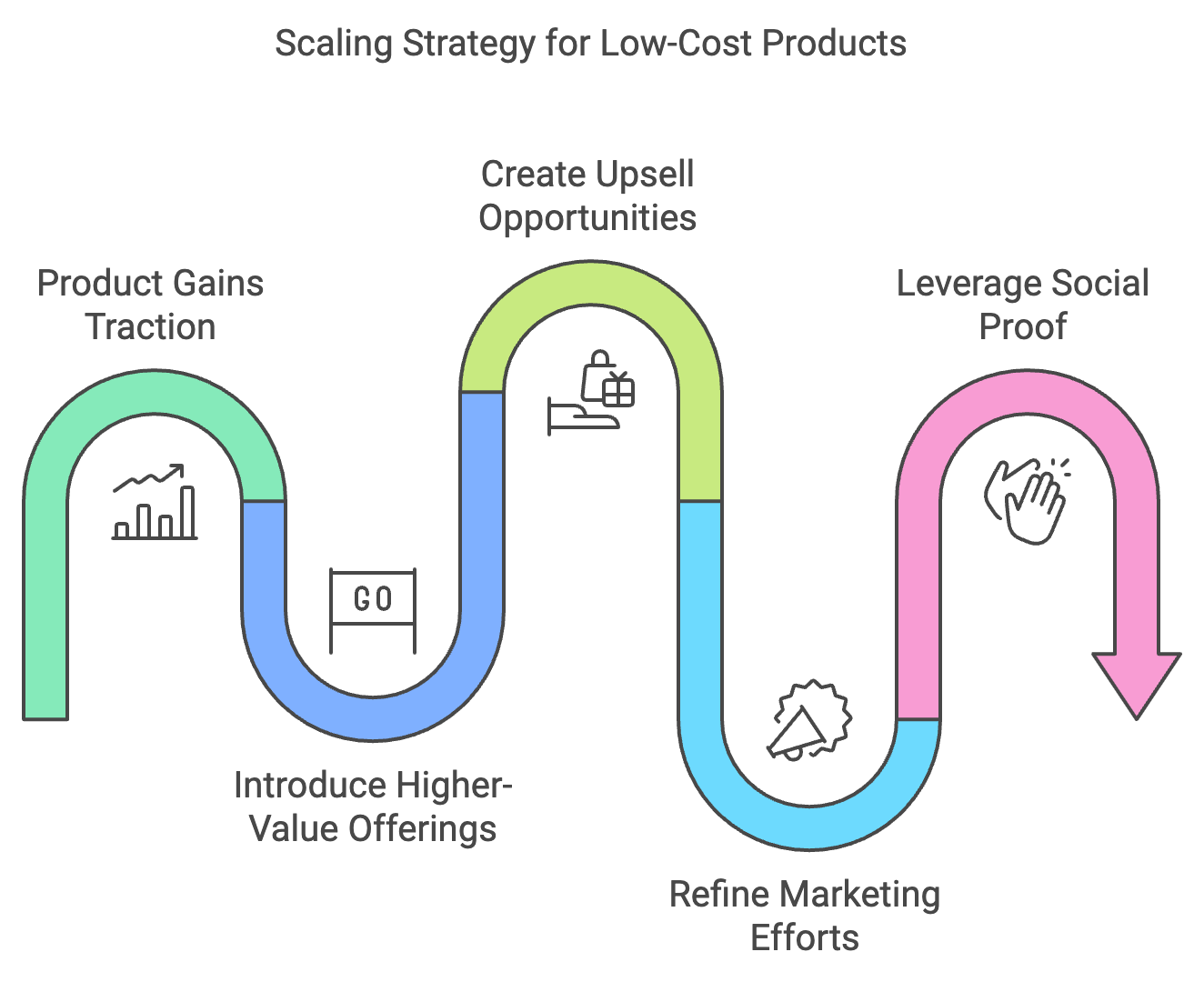
3.5. Case Study Insight: Notion Library Launch to $5k Client Conversion
An excellent example of low-risk validation to high-ticket conversion comes from launching a simple Notion template library. Initially priced at $29, the product was targeted toward productivity enthusiasts and content creators, solving a clear organizational need. Sales confirmed audience demand, and the success of this small product led directly to a high-ticket offer—ultimately resulting in a $5,000 ghostwriting client for content strategy services.
Key Takeaways from the Case Study:
- Demand Validation Through Low-Cost Offerings: The initial Notion library validated demand within the productivity niche.
- Expansion Based on Audience Needs: Observing customer feedback and engagement allowed the creator to expand services to higher-value consulting.
- Building Trust and Authority: The success of the low-cost product established credibility, making high-ticket services a natural extension.
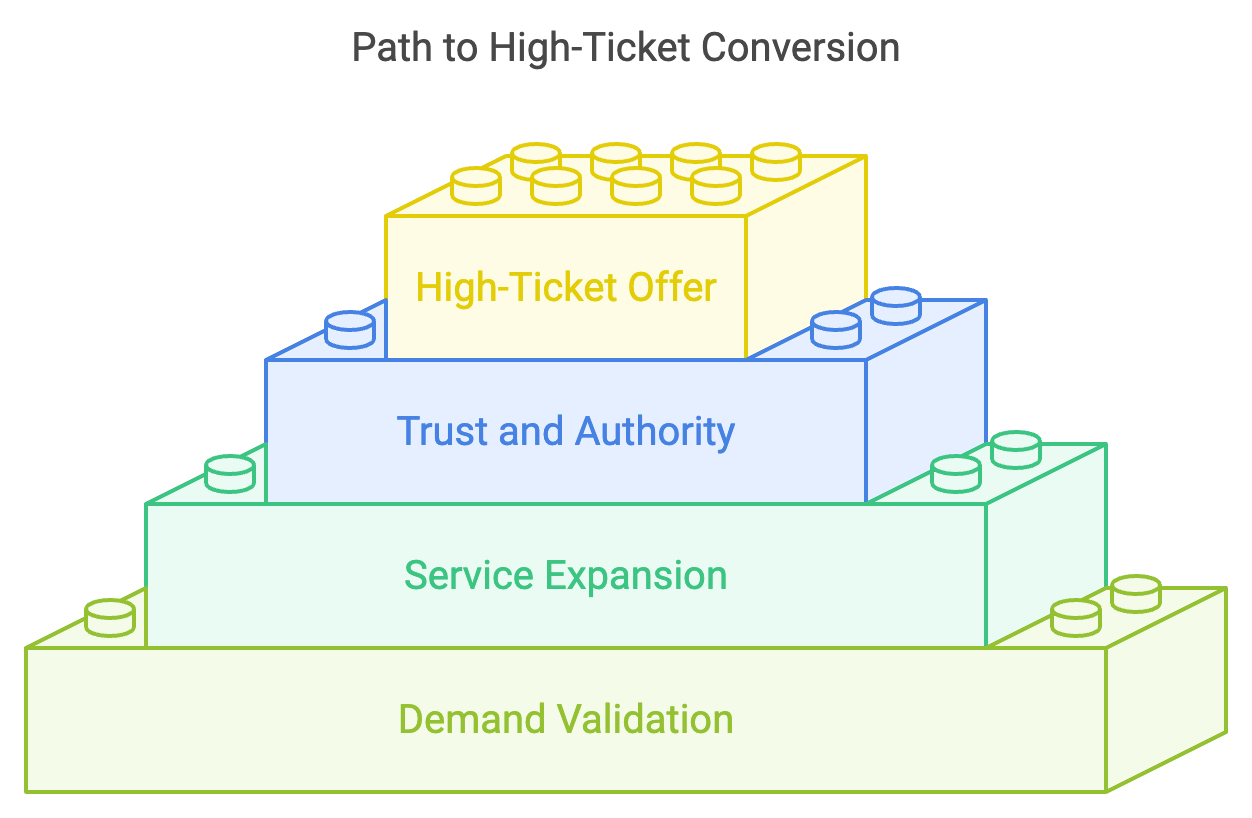
4. Differentiating Input vs. Output Thinking
4.1. Shifting Mindsets: From Trading Time for Money to Building Scalable Assets
The core of successful digital entrepreneurship lies in shifting from a mindset focused on input (effort and hours worked) to output (results and impact). Traditional work models often reward time spent rather than results produced, which can limit growth potential. In a digital business, however, value is measured by the impact and scalability of efforts, making it essential to focus on building assets that generate income independently of time invested.
Key Aspects of Output Thinking:
- Value Creation Over Effort: Prioritize tasks that yield significant results rather than simply occupying time.
- Scalability Focus: Develop products or systems that serve multiple clients or customers without proportional increases in effort.
- Results-Driven Decisions: Evaluate projects based on potential outcomes rather than the resources they consume.
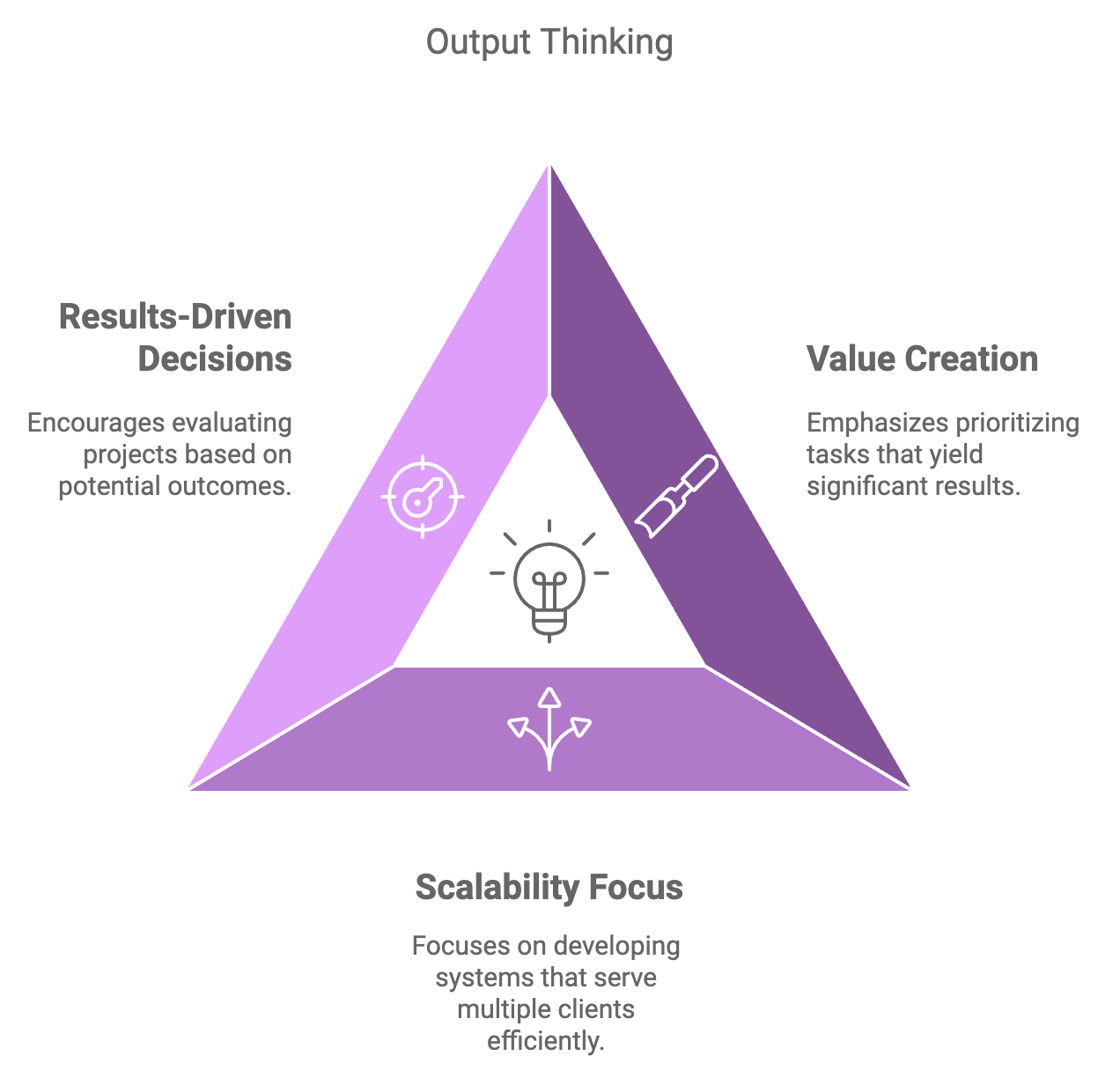
4.2. Applying the Pareto Principle to Identify High-Impact Activities
The Pareto Principle, or the 80/20 rule, suggests that 80% of results come from 20% of efforts. For digital entrepreneurs, identifying and focusing on these high-impact tasks is key to maximizing efficiency and scaling without overextending resources.
Steps to Apply the Pareto Principle:
- Analyze Your Activities: Track daily tasks and evaluate which ones directly impact revenue and growth.
- Identify High-Yield Actions: Determine the small set of activities that bring the highest return, such as creating content, product development, or customer engagement.
- Eliminate Low-Impact Efforts: Reduce or delegate tasks that consume time without significant results, such as routine administrative work or unnecessary meetings.
- Double Down on What Works: Invest more time and resources into the top 20% of activities, amplifying efforts that drive the most growth and income.
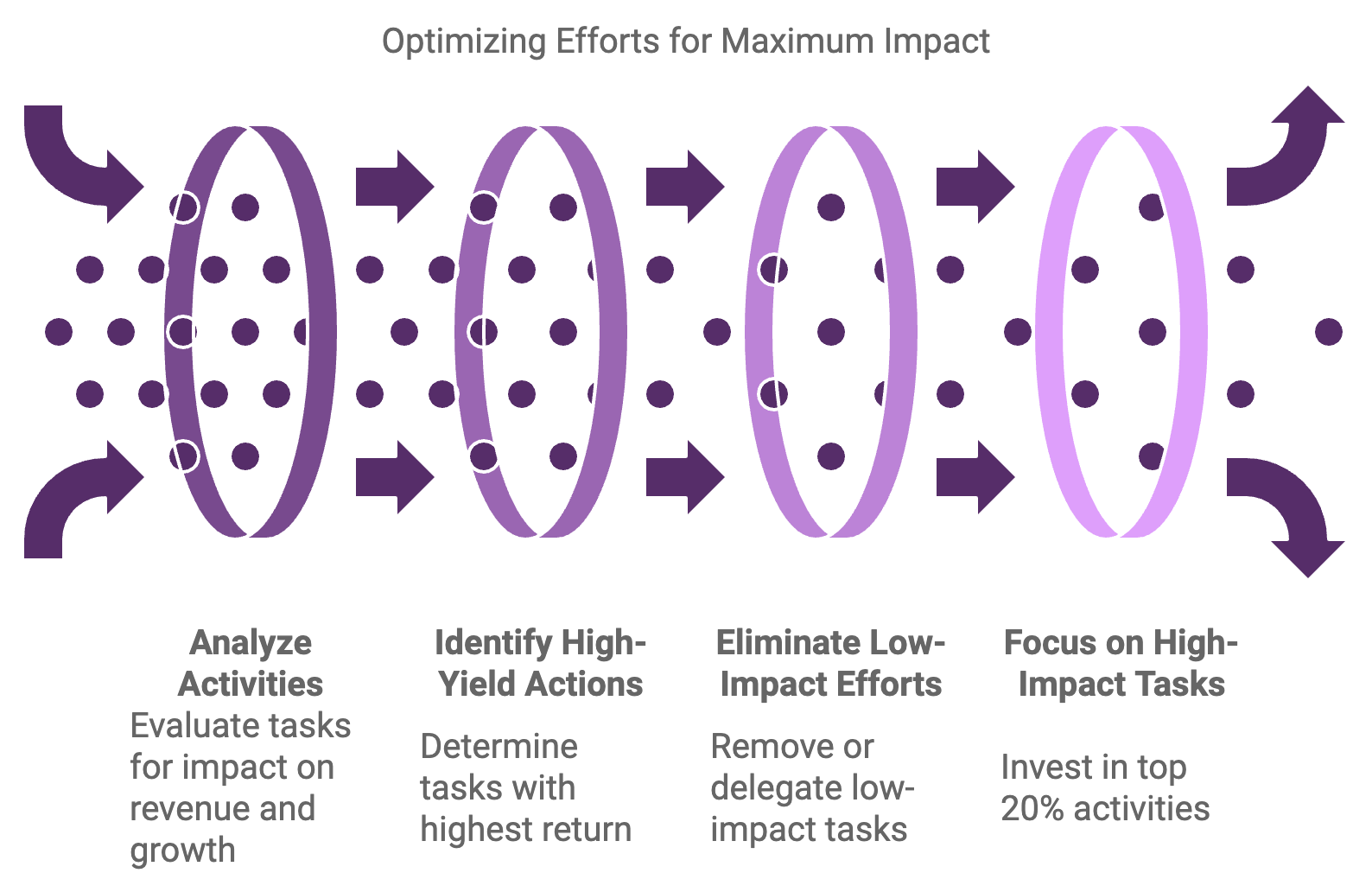
4.3. Creating Repeatable Assets for Passive Income
One of the most effective ways to shift from an input-focused model to output thinking is by developing repeatable assets that generate passive income. Rather than trading hours for dollars, scalable assets—like digital products, courses, or automated services—allow you to serve more clients or customers with the same amount of effort.
Types of Repeatable Assets:
- Digital Courses and E-books: Once created, these assets can be sold repeatedly without additional production costs.
- Templates and Toolkits: Resources like templates, Notion libraries, or downloadable toolkits provide ongoing value with minimal maintenance.
- Membership Programs: A subscription model offers a steady income stream and recurring engagement, allowing members to access resources or content on an ongoing basis.
- Automated Services: Tools like email marketing funnels or scheduling platforms can handle customer interactions without manual intervention, creating a seamless experience for clients and freeing up time for you.
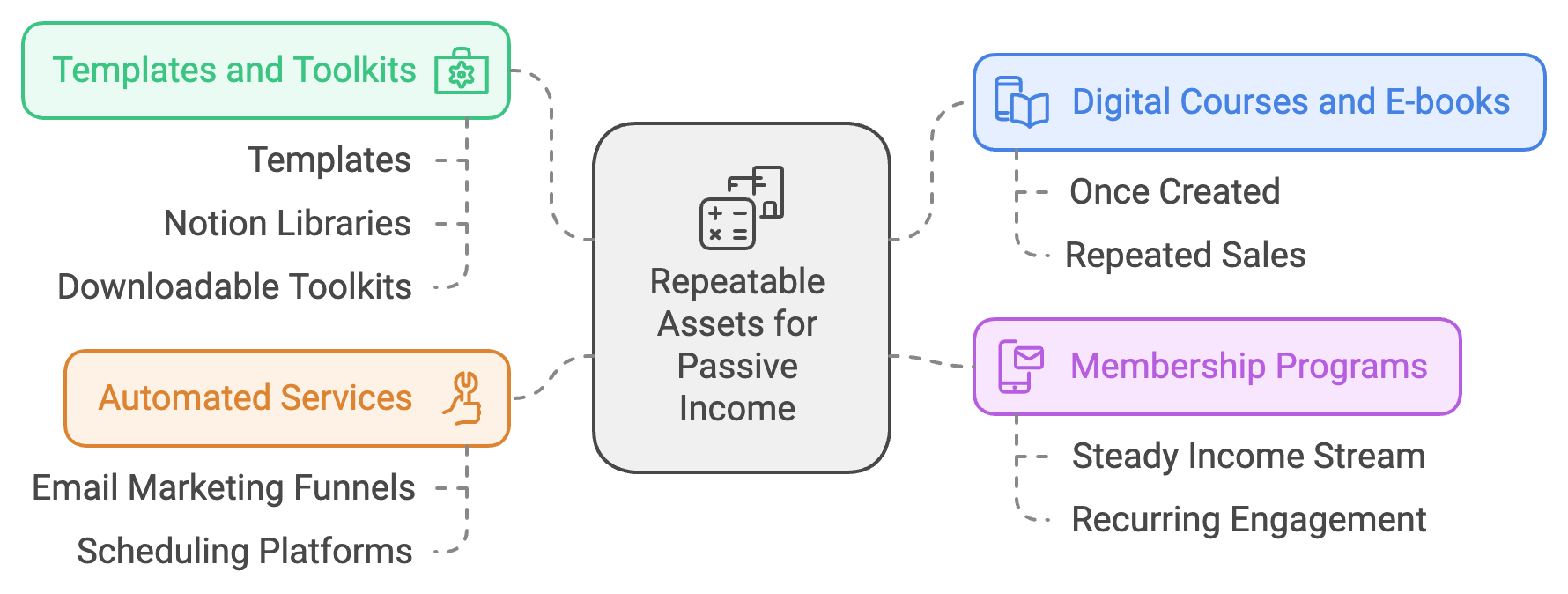
4.4. Case Study Insight: Launching "Ship 30 for 30" Writing Challenge
A notable example of transitioning from time-based effort to scalable output is the creation of the "Ship 30 for 30" writing challenge. This challenge, designed to help aspiring writers develop an online writing habit, was crafted as a repeatable, structured program that delivered immense value to participants with limited ongoing time commitment from the creators.
Success Factors of the "Ship 30 for 30" Challenge:
- Clear, Niche Focus: The program targeted a specific audience (beginner writers) with a clear objective (building a writing habit).
- Scalability: The program’s design allowed large numbers of participants to join without increasing the creators’ workload, as most resources were pre-made and accessed digitally.
- Community and Accountability: Participants benefited from a sense of community and structured accountability, both of which were facilitated through digital platforms rather than one-on-one time commitments.
- Consistent Income Stream: By setting up the challenge as a recurring, monthly event, the creators established a dependable income flow, effectively building an asset that continued to generate revenue.
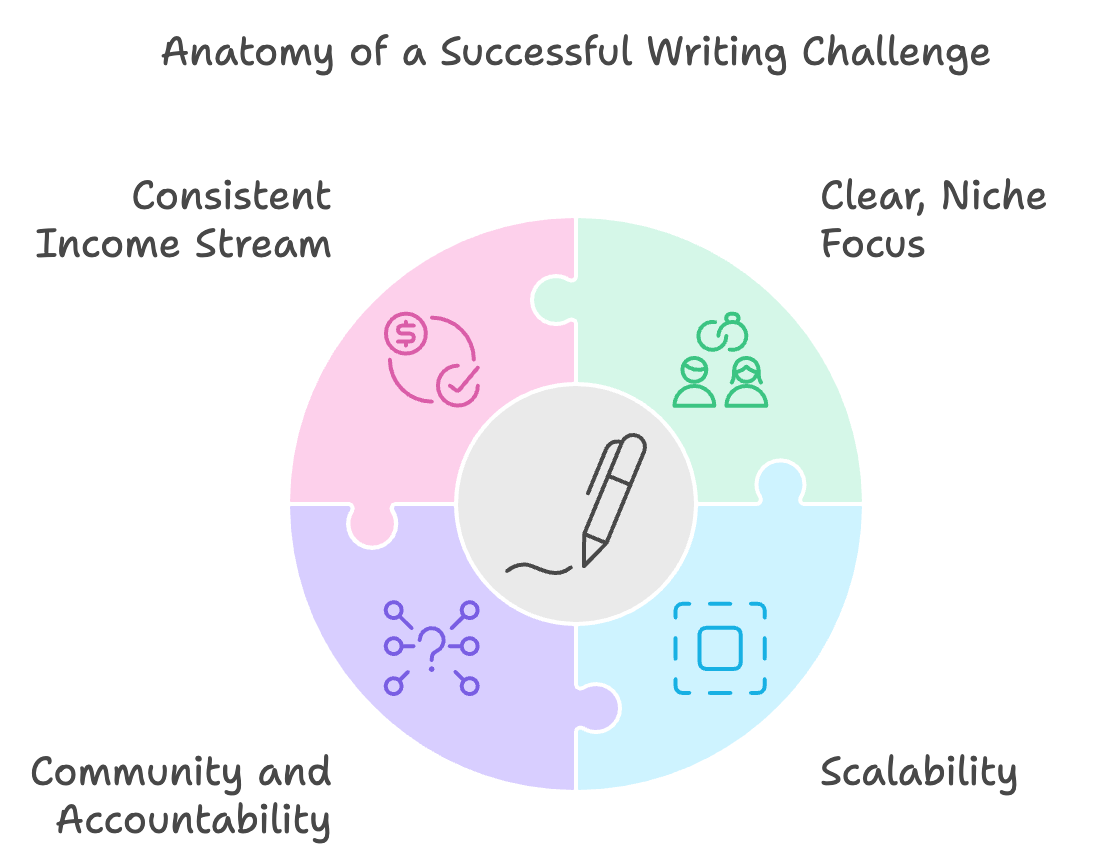
Key Takeaway: By shifting from hourly commitments to scalable, repeatable assets, digital entrepreneurs can create sustainable, passive income streams. This approach maximizes impact and profitability, helping to achieve substantial growth without requiring direct time investment for each customer or sale.
5. Niching Down Your Offer for Maximum Impact
5.1. Importance of a Clear and Focused Offer
In a saturated digital marketplace, one of the most powerful strategies for business growth is a focused and niche-specific offer. Niching down enables you to hone in on a specific audience segment and solve a precise problem, setting your business apart from broader, more generalized competitors. This focus not only differentiates your brand but also attracts a loyal customer base that values specialized solutions tailored to their unique needs.
Advantages of a Focused Offer:
- Clear Targeting: A niche offer makes it easier to identify and target your ideal customers, improving the effectiveness of your marketing.
- Higher Perceived Value: Specialized solutions are often perceived as more valuable, allowing you to command higher prices and gain customer trust.
- Reduced Competition: By narrowing your focus, you reduce the number of competitors vying for the same audience, carving out a space for your brand to thrive.
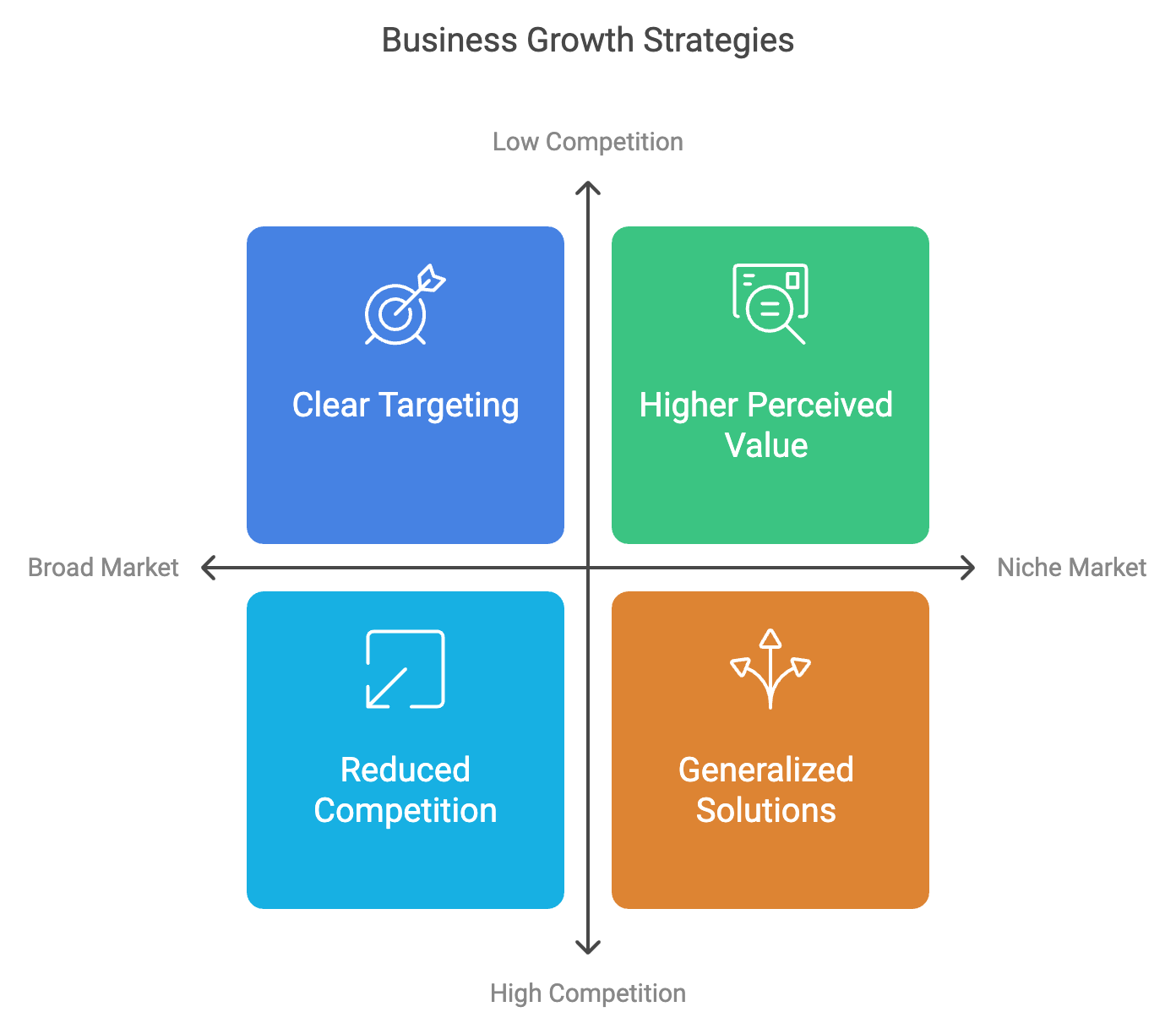
5.2. Steps to Identify Your Niche Audience and Their Unique Problems
Identifying the right niche involves a balance of market research, introspection, and an understanding of audience needs. This process ensures that you’re developing an offer that not only resonates but has genuine demand and long-term growth potential.
Key Steps to Find Your Niche:
- Analyze Your Skills and Interests: Begin by examining your own expertise and passions. A niche rooted in your strengths and interests is more sustainable and aligns with your long-term goals.
- Research Market Gaps: Study competitors and industry trends to identify underserved segments or gaps. Look for areas where existing solutions are lacking or fail to address customer pain points effectively.
- Define the Audience’s Specific Problem: Narrow down to a specific pain point that you can solve uniquely well. The more precise the problem, the stronger your solution can resonate.
- Validate Demand: Use social media, forums, or surveys to test if there’s real interest in your solution. Audience feedback can confirm demand and reveal additional needs or preferences within your niche.
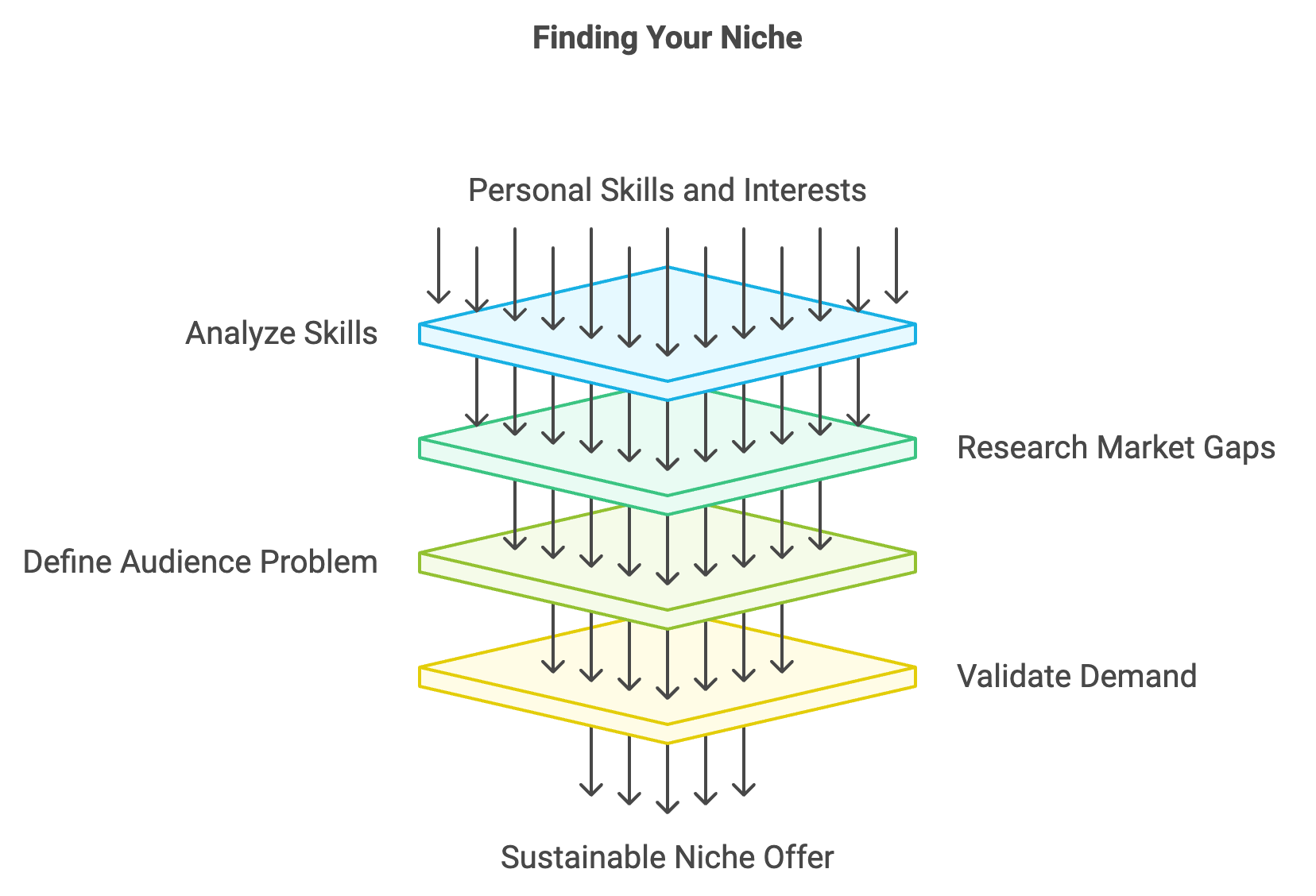
5.3. How to Craft a Solution that Meets a Specific Need for a Specific Audience
Once you’ve identified a niche and a key problem, crafting an effective solution requires clarity, simplicity, and alignment with your target audience’s expectations. The best solutions are those that directly address a single pain point with tangible, high-impact outcomes.
Guidelines for Developing a Niche Solution:
- Keep the Offer Specific: Resist the urge to solve multiple problems within one offer. Focus on delivering a single, impactful solution that stands out in the market.
- Emphasize Outcomes: Clearly communicate the benefits and outcomes your customers can expect. Use testimonials, case studies, or before-and-after scenarios to showcase the value of your offer.
- Streamline for User Experience: A streamlined, straightforward solution is easier for customers to understand and use, increasing satisfaction and likelihood of repeat business.
- Adjust Based on Feedback: Continuously improve your offer based on customer feedback. This iterative approach ensures your solution remains relevant and closely aligned with evolving customer needs.
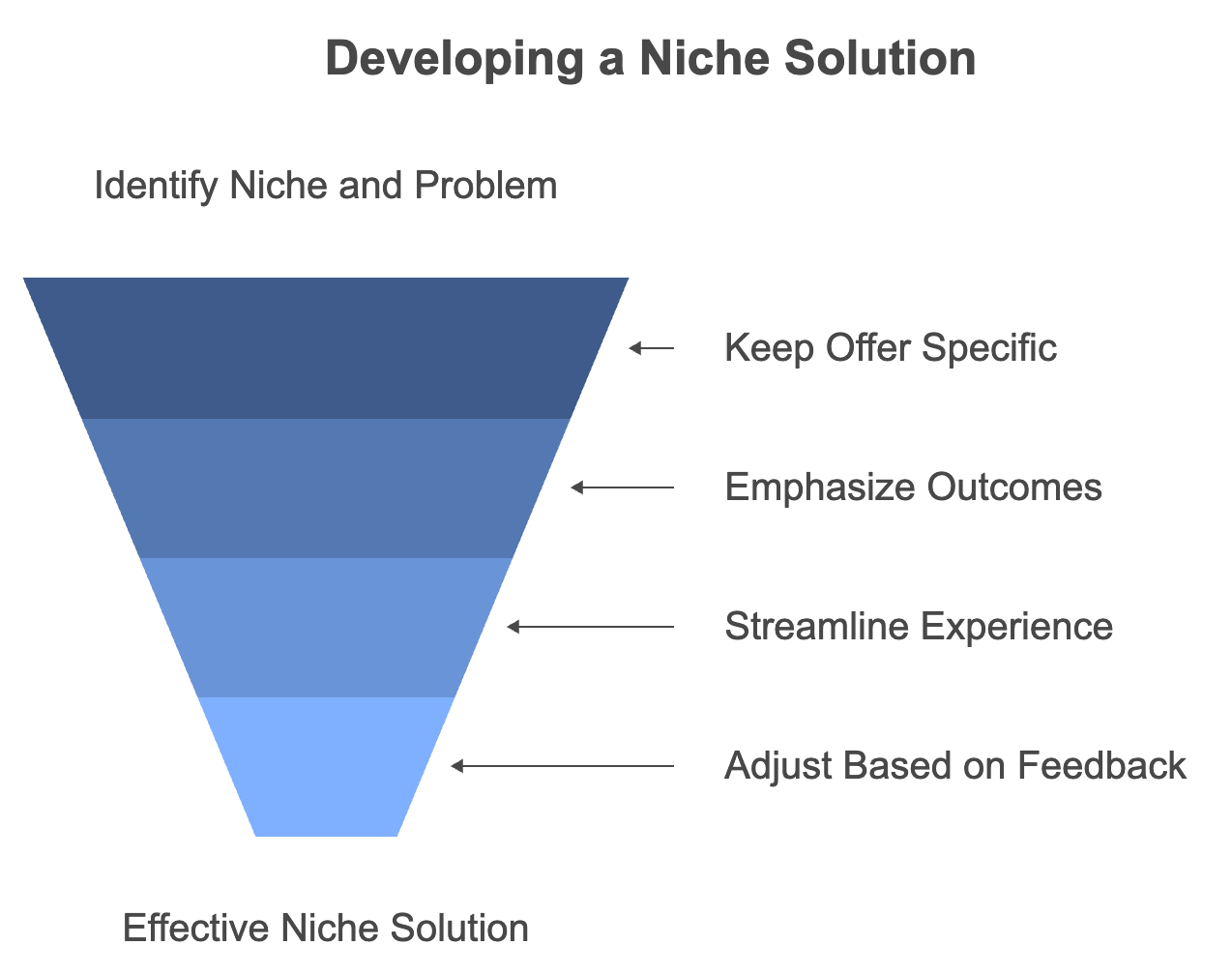
5.4. Case Study Insight: Focusing on Beginner Writers to Build a Flagship Product
An example of niching down for maximum impact is the creation of a flagship product aimed specifically at beginner writers who want to improve their online writing skills. By addressing a clear need—helping new writers develop consistent writing habits and master online platforms—this offer became highly targeted, resonating with a specific audience and establishing itself as a go-to resource.
Success Factors of the Beginner Writer Product:
- Targeted Problem Solving: The product tackled a well-defined problem—beginner writers struggling with consistency and visibility online.
- Step-by-Step Approach: Offering a structured, guided 30-day writing challenge allowed customers to achieve measurable progress in a short time.
- Clear and Consistent Branding: The product was branded as the ultimate resource for aspiring writers, which reinforced its position in the market and built trust.
- Community Support: A community element allowed participants to engage with peers, adding value and encouraging accountability, both of which increased completion rates and customer satisfaction.
Takeaway: A focused, niche product allows digital entrepreneurs to become recognized leaders within a specific market segment. By prioritizing audience-specific problems and solutions, businesses not only build authority but also establish a loyal customer base eager for specialized value.
6. Reinvesting in Yourself and Your Business
6.1. Why Reinvestment is Key to Growth and Long-Term Success
Reinvestment is an essential strategy for scaling a digital business, fostering continuous improvement and positioning you to seize new opportunities. Allocating a portion of profits toward skill development, resources, and network expansion allows entrepreneurs to stay competitive, broaden their influence, and adapt to changes within their industry. Reinvestment transforms a static business model into a dynamic one, supporting sustainable growth and enhancing your brand’s credibility.
Key Benefits of Reinvestment:
- Continuous Skill Enhancement: Staying at the forefront of industry knowledge and trends to improve service or product quality.
- Broader Network Access: Expanding your professional circle for collaboration, insights, and potential partnerships.
- Operational Efficiency: Investing in tools and resources that streamline processes, saving time and money in the long run.
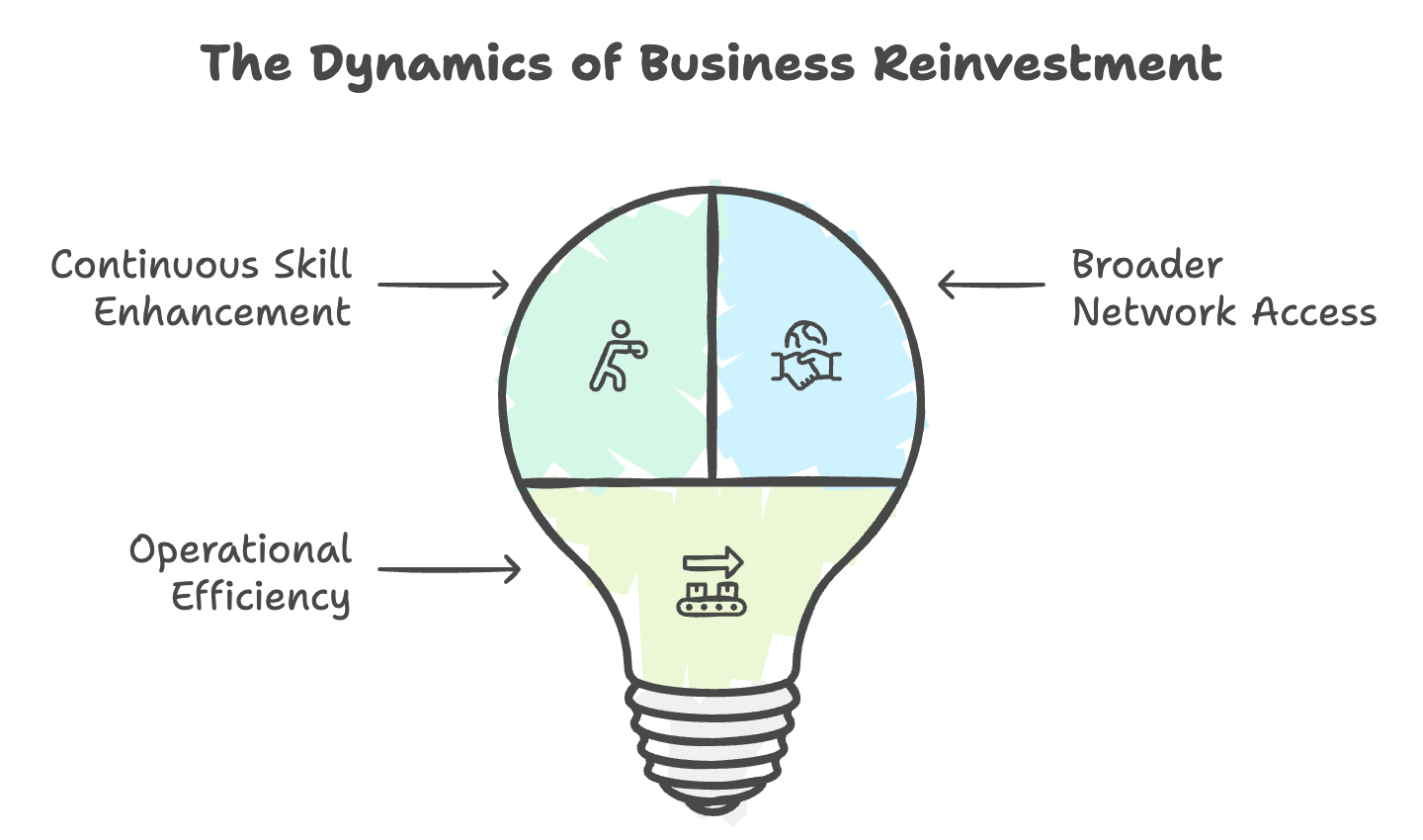
6.2. Allocating a Portion of Profits to Skill Development and Mentorship
To foster growth, reinvestment in skill development and mentorship is invaluable. Entrepreneurs who prioritize learning and mentorship are more likely to outperform their peers, as they consistently refine their expertise and gain insights that influence their strategic decisions. Dedicate a percentage of your revenue to courses, workshops, and mentorship programs that address your business’s unique needs.
Suggested Allocation for Skill Development:
- Courses and Certifications: For mastering new tools, marketing strategies, or technical skills relevant to your niche.
- Mentorship and Coaching: Accessing experienced mentors offers practical guidance and perspective, accelerating your growth.
- Industry Events and Conferences: Attending events provides networking opportunities and firsthand exposure to industry trends and innovations.
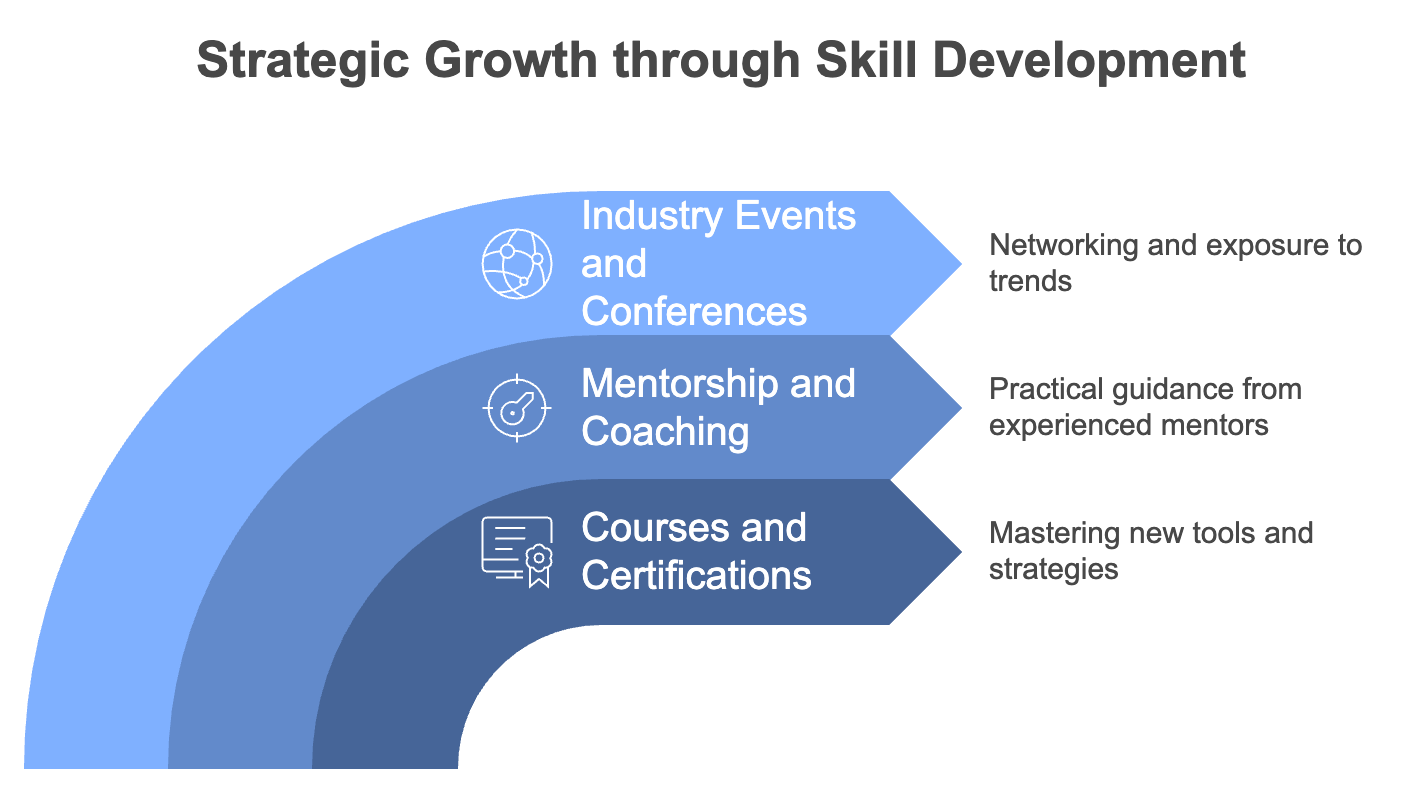
6.3. Types of Educational Investments to Consider: Courses, Masterminds, and Networking
Reinvestment in education helps entrepreneurs develop both tactical skills and strategic insights. Each type of educational investment serves a different purpose and can be tailored to meet specific growth objectives.
1. Courses and Certifications
Courses allow you to expand your expertise in a structured environment. They are beneficial for gaining technical knowledge, mastering platforms, or learning specific techniques, such as SEO or content strategy, that can directly impact your business.
2. Mastermind Groups
Mastermind groups bring together like-minded entrepreneurs who exchange ideas, troubleshoot challenges, and hold each other accountable. The collaborative environment encourages high-level problem solving, making masterminds a powerful tool for growth.
3. Networking Opportunities
Events, conferences, and workshops provide essential networking platforms. Interacting with industry professionals offers insights, collaboration possibilities, and introductions to influencers who can expand your business reach. These connections can be instrumental in discovering new tools, learning about industry best practices, and even securing clients or collaborators.
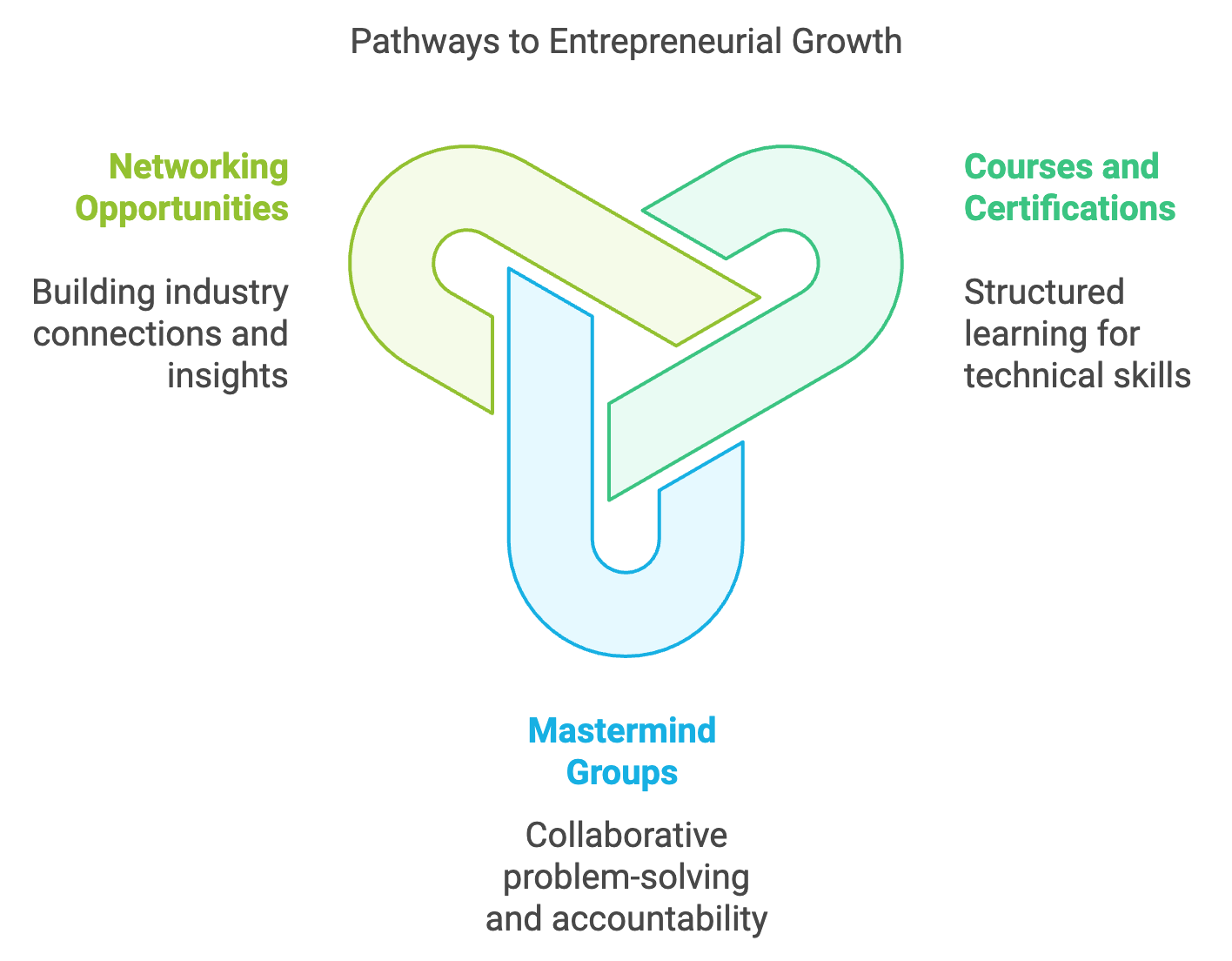
6.4. Case Study Insight: The $68k Mastermind Investment That Led to a 5x ROI
One entrepreneur’s experience with a $68,000 investment in a high-ticket mastermind demonstrates the transformative power of reinvestment. This mastermind provided access to expert-led sessions, industry-leading resources, and a network of highly successful peers. Over time, the insights and connections gained from this experience directly contributed to a fivefold return on investment, generating substantial revenue and elevating the entrepreneur’s business profile.
Factors Contributing to the Mastermind’s Success:
- High-Caliber Network: Members of the mastermind were established entrepreneurs with valuable insights and experience, creating a strong learning environment.
- Strategic Guidance: The sessions helped refine business strategies, providing clarity on scaling and revenue diversification.
- Long-Term Partnerships: The connections made during the mastermind led to partnerships, client referrals, and cross-promotional opportunities.
Key Takeaway: Investing in a high-quality mastermind or similar educational experience can offer exponential returns by connecting you to individuals and insights that significantly accelerate your growth. Reinvestment in strategic educational resources amplifies your business’s capacity to innovate and succeed, unlocking paths to new revenue and professional development.
7. Why This Framework Works and How to Leverage It
7.1. Minimizing Financial and Operational Risks
A significant advantage of this framework is its built-in approach to risk minimization. By starting with low-cost products, maintaining a side income from full-time work, and reinvesting cautiously, entrepreneurs can avoid substantial financial losses. This step-by-step scaling approach reduces the likelihood of large investments failing, enabling growth that is both sustainable and adaptive.
Key Strategies for Risk Minimization:
- Low-Cost Product Testing: Validate ideas with affordable, easy-to-produce offerings to gauge demand before committing resources to larger projects.
- Incremental Scaling: Instead of high-stakes launches, grow incrementally by expanding successful products and refining them based on feedback.
- Controlled Reinvestment: Allocate a set percentage of profits back into the business, ensuring capital is reinvested only when it’s genuinely warranted for growth.
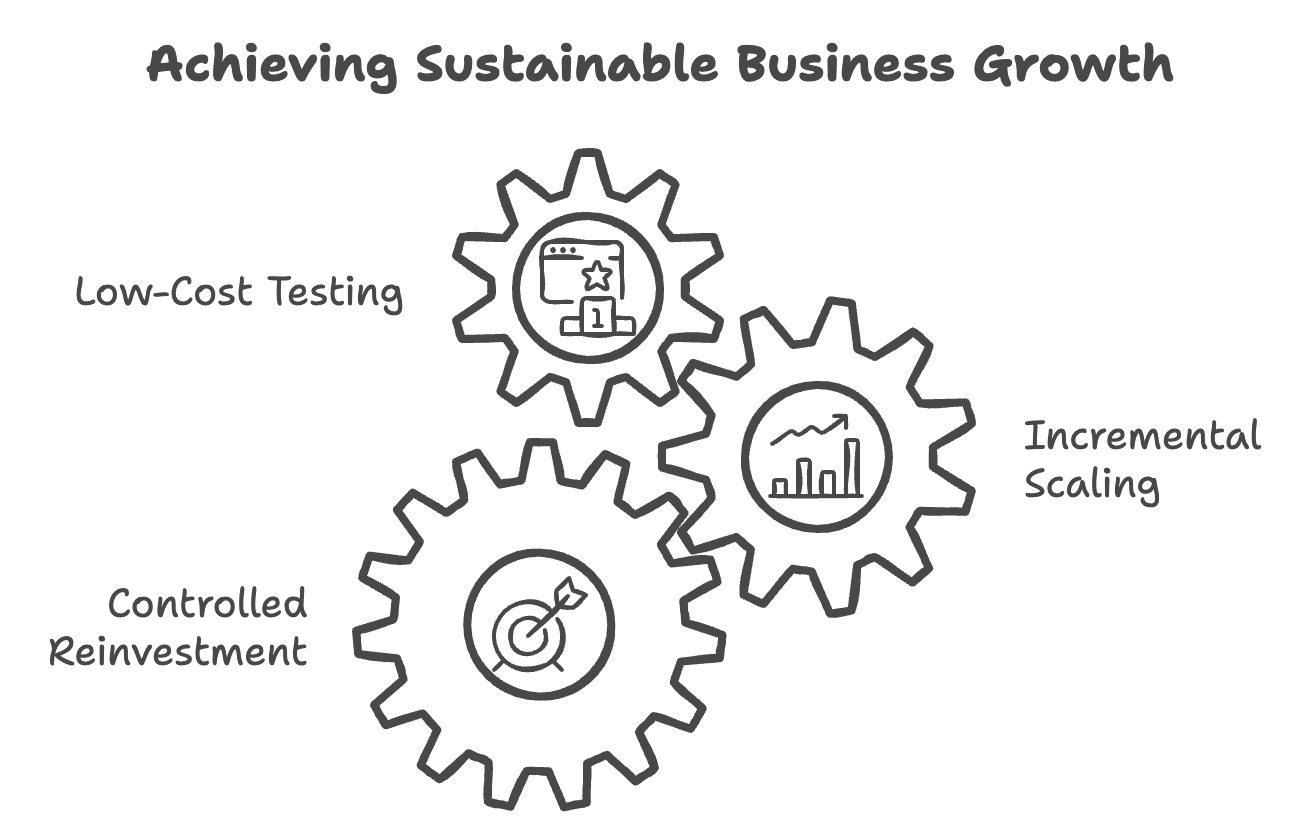
7.2. Validating Ideas Iteratively to Reduce Investment Risks
This framework encourages an iterative approach to business ideas, where each step involves testing, feedback collection, and refinement. By validating ideas early on, entrepreneurs can avoid investing in concepts without demand, reducing both financial and operational risks.
Steps for Iterative Validation:
- Initial Market Research: Analyze trends, competitors, and target audience needs to create a concept that aligns with market demand.
- Launch a Minimum Viable Product (MVP): Offer a basic version of your product or service to test market interest without overcommitting resources.
- Collect and Analyze Feedback: Engage early users for insights, and use their feedback to make informed adjustments.
- Expand Based on Data: Once validated, expand or improve the product incrementally, relying on data-driven decisions rather than assumptions.
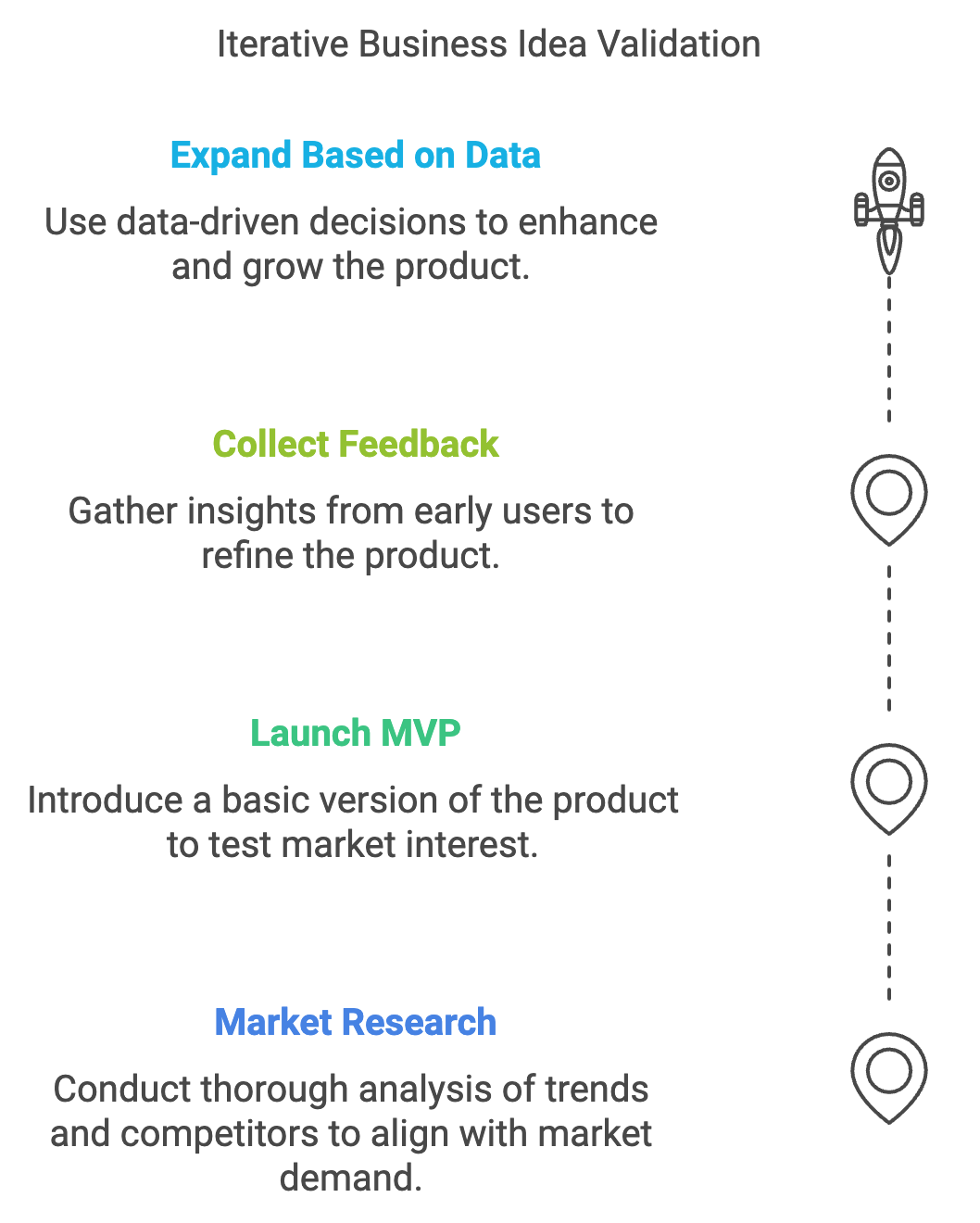
7.3. Building One Flagship Product to Simplify Scaling and Revenue Generation
Focusing on a flagship product—a single high-value offering—allows businesses to scale more effectively. A well-defined product streamlines marketing, customer service, and operational efforts, enhancing brand identity and making it easier to achieve consistency in quality.
Benefits of a Flagship Product:
- Streamlined Marketing: Marketing efforts concentrate on one product, amplifying brand messaging and reducing audience confusion.
- Resource Efficiency: Focusing on a single offer minimizes the need for a wide inventory or complex logistics, keeping costs manageable.
- Customer Loyalty: A flagship product creates a core brand identity, making it easier to build a community of loyal users who trust your offerings.
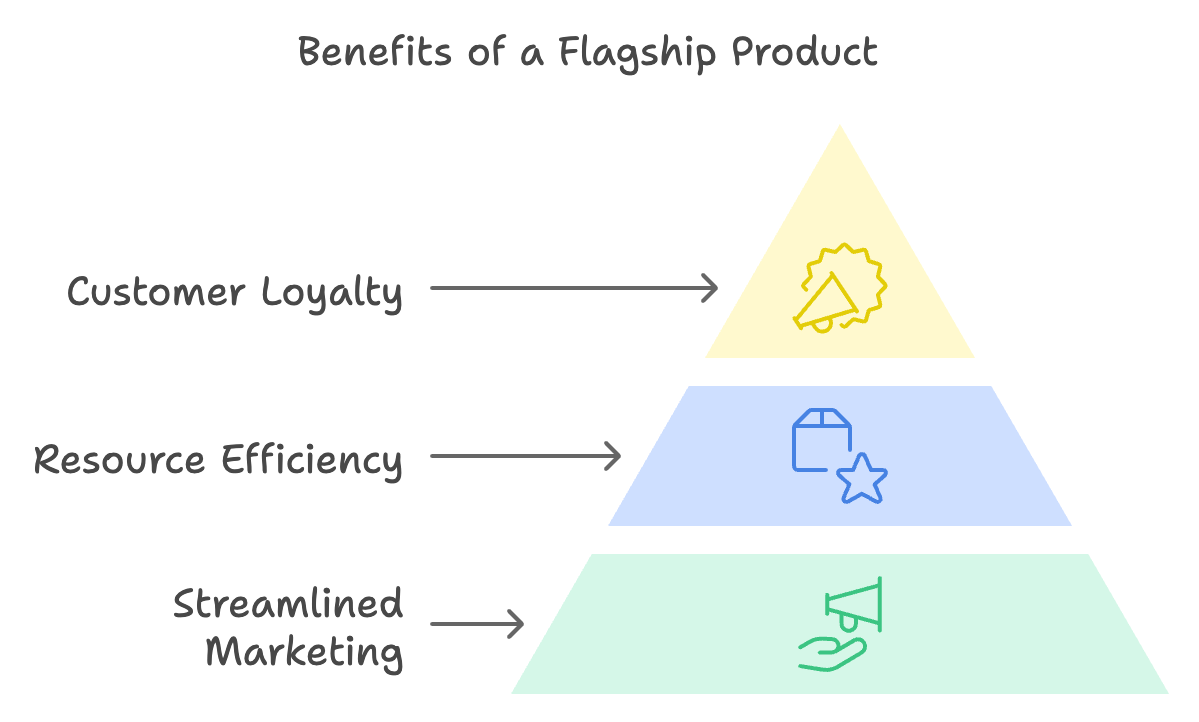
7.4. Reinvesting in Growth to Avoid Stagnation and Open New Opportunities
Continual reinvestment is essential for staying competitive and maintaining momentum. This framework encourages reinvesting a portion of profits into new tools, market research, or additional training to ensure the business evolves alongside industry trends.
Areas for Strategic Reinvestment:
- Technology and Automation: Invest in tools that enhance productivity or customer experience, such as email automation or analytics platforms.
- Content and Marketing Expansion: As revenue grows, consider new content strategies or advertising channels to reach broader audiences.
- Professional Development: Join industry workshops, attend conferences, or enroll in courses to stay updated with the latest skills and trends.
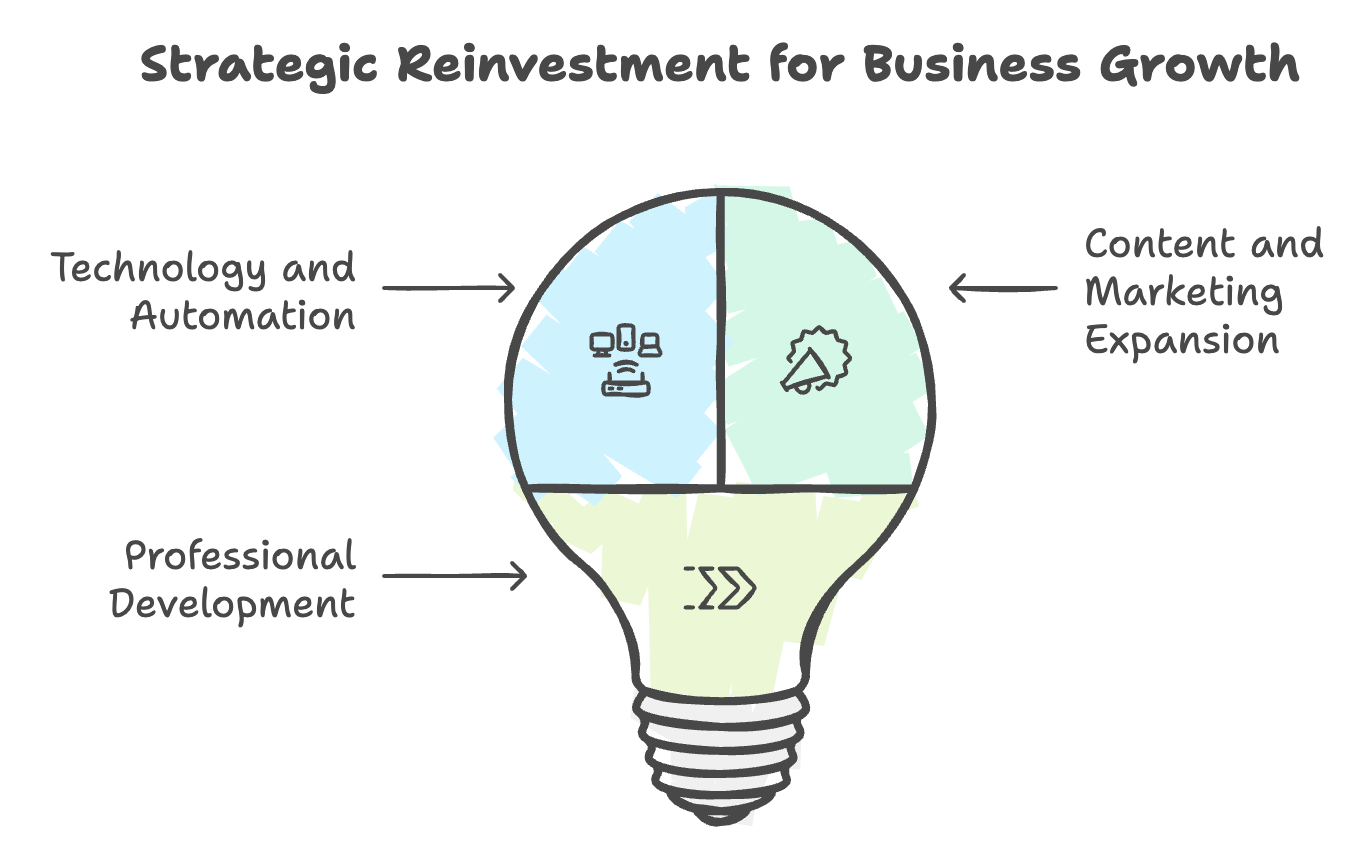
7.5. Leveraging Digital Assets for Sustainable, Scalable Revenue
A core principle of this framework is the creation of digital assets that generate income with minimal ongoing effort. Unlike service-based businesses that require constant time investment, digital assets—like e-books, online courses, and templates—allow for scalable revenue without proportional labor.
Advantages of Digital Assets:
- Passive Income Generation: Digital products can be sold repeatedly with little or no additional cost per sale, creating a consistent revenue stream.
- Broader Market Reach: Digital assets can be marketed and accessed globally, extending reach far beyond local boundaries.
- Scalability: These assets allow businesses to serve more customers without the limitations of physical products or services, supporting growth without added overhead.
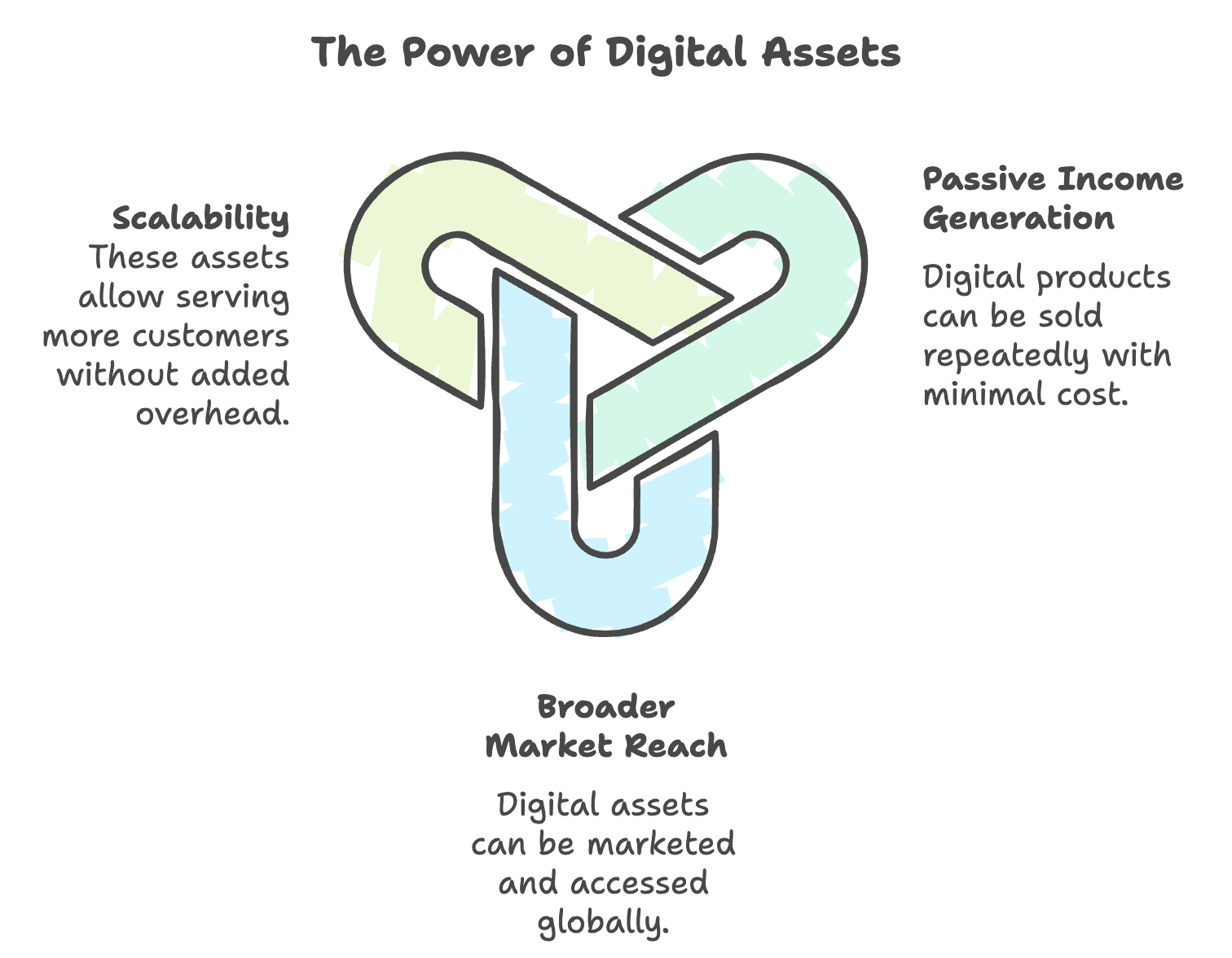
By following this framework, entrepreneurs can build a robust, low-risk digital business that steadily scales. Through focused offerings, strategic reinvestment, and the power of digital assets, this approach lays a foundation for sustainable growth while minimizing the pitfalls that often accompany rapid scaling attempts.
8. Putting It into Practice: Actionable Steps to Start Building
8.1. Choosing a Skill or Knowledge Area to Monetize
The foundation of a successful digital business lies in identifying a skill or knowledge area that aligns with market demand and your strengths. This selection should not only resonate with your experience and interests but also address a specific need or pain point in the market.
Steps to Identify a Monetizable Skill:
- Self-Assessment: Evaluate your expertise and passions. Think about what you’re naturally skilled at or have professional experience in.
- Market Research: Identify gaps in the market where your skills could provide a unique solution. Use social media, forums, or keyword tools to gauge interest.
- Validate Demand: Ensure there’s sufficient interest in your chosen area by testing ideas on platforms like Twitter, LinkedIn, or through Google Trends.
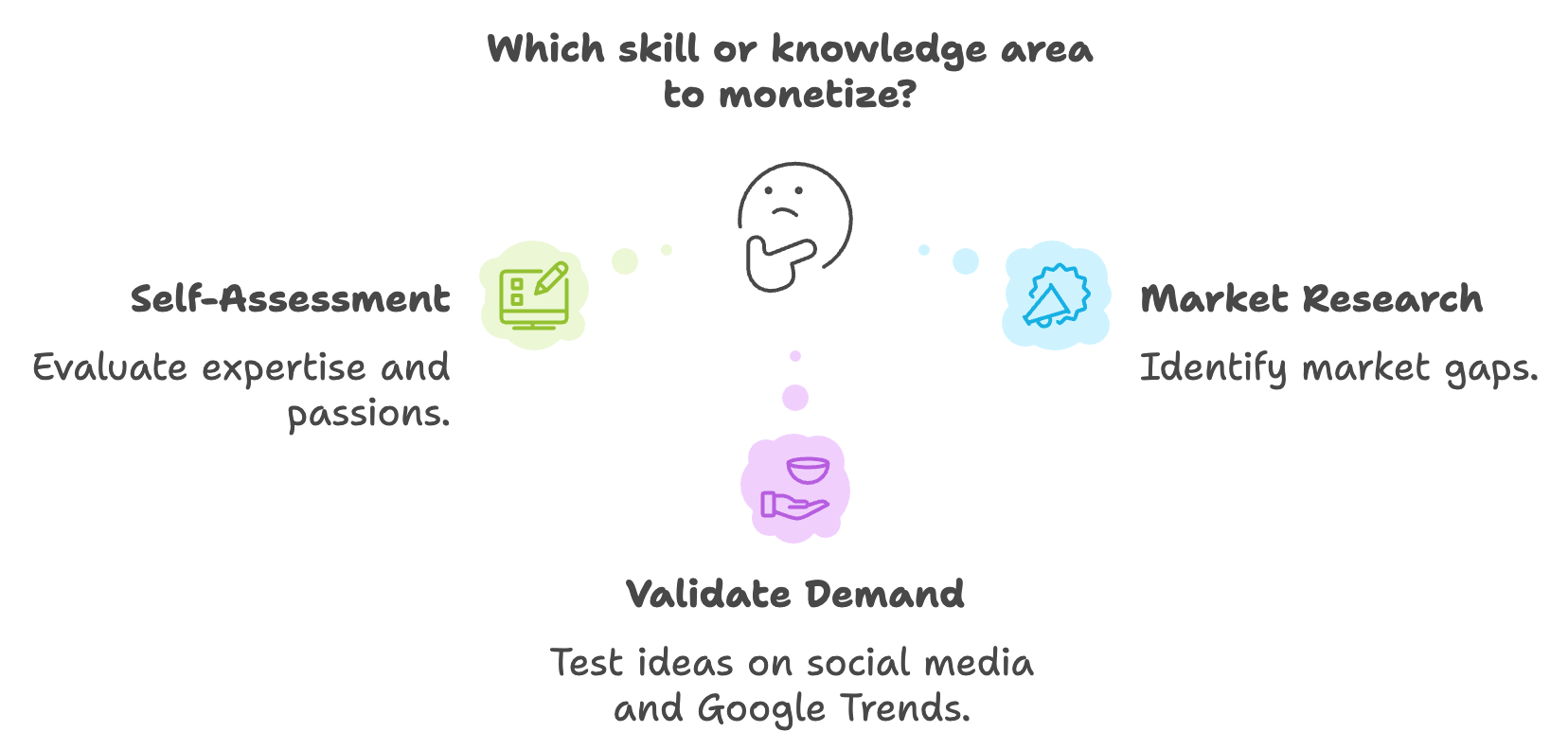
8.2. How to Develop Social Proof and Utilize Feedback Loops
Social proof plays a crucial role in establishing trust and credibility. Gathering testimonials, showcasing results, and engaging with your audience can significantly boost your brand’s authority. Additionally, using feedback loops allows you to continually refine your offerings based on customer needs and preferences.
Building Social Proof
- Gather Testimonials: Request feedback and testimonials from early clients or users. These provide authentic endorsements for your services or products.
- Showcase Results: Share case studies, metrics, or success stories that highlight your impact, especially on platforms like LinkedIn or your website.
- Leverage User-Generated Content: Encourage satisfied customers to share their experiences on social media, amplifying your brand’s reach and trustworthiness.
Utilizing Feedback Loops
- Surveys and Polls: Conduct periodic surveys to understand user satisfaction and identify areas for improvement.
- Engage with Community: Create open channels (e.g., social media groups, email newsletters) where users can provide ongoing feedback.
- Iterate Based on Data: Regularly review feedback data and make incremental changes to enhance product fit and customer satisfaction.
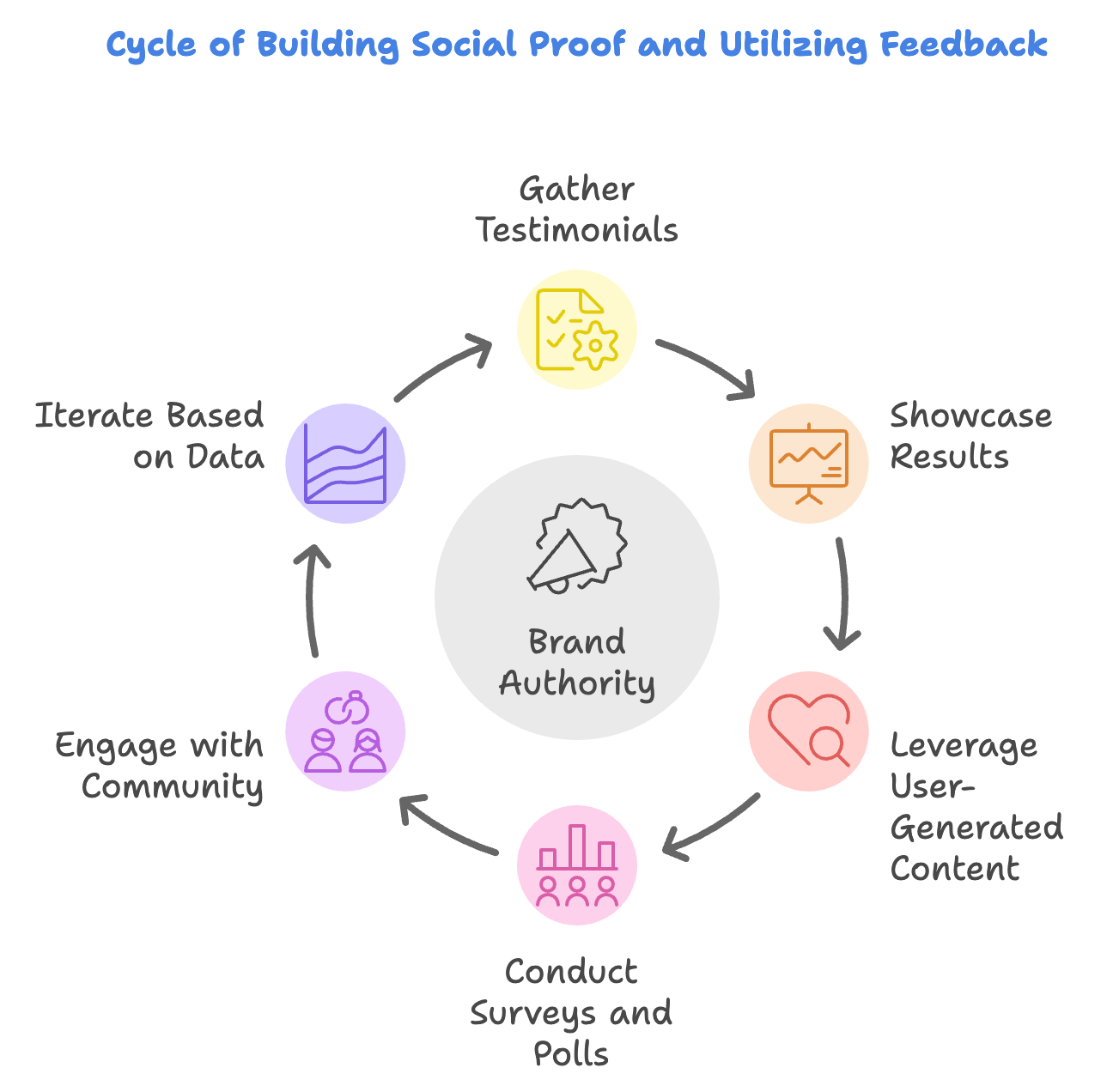
8.3. Automating and Scaling: Using Tools to Streamline Operations
To scale efficiently, automation is essential. Leveraging digital tools to handle repetitive tasks frees up time for strategic growth activities, making your operations smoother and more sustainable as your business expands.
Essential Tools for Automation
- Email Marketing Automation: Use tools like Mailchimp or ConvertKit to automate welcome sequences, nurture emails, and segment contacts based on engagement.
- Sales Funnels: Set up sales funnels that guide prospects from awareness to purchase. Platforms like ClickFunnels or Leadpages can streamline this process.
- Task Management Systems: Tools like Trello or Asana help organize projects and automate task assignments, improving workflow and efficiency.
Scaling Through Automation
- Standardize Processes: Document and standardize repetitive tasks so that they can be automated or delegated easily.
- Automate Customer Engagement: Schedule regular social media posts and use chatbots for immediate response to customer queries.
- Leverage Analytics: Use data from platforms like Google Analytics to monitor performance and adjust strategies for optimal growth.
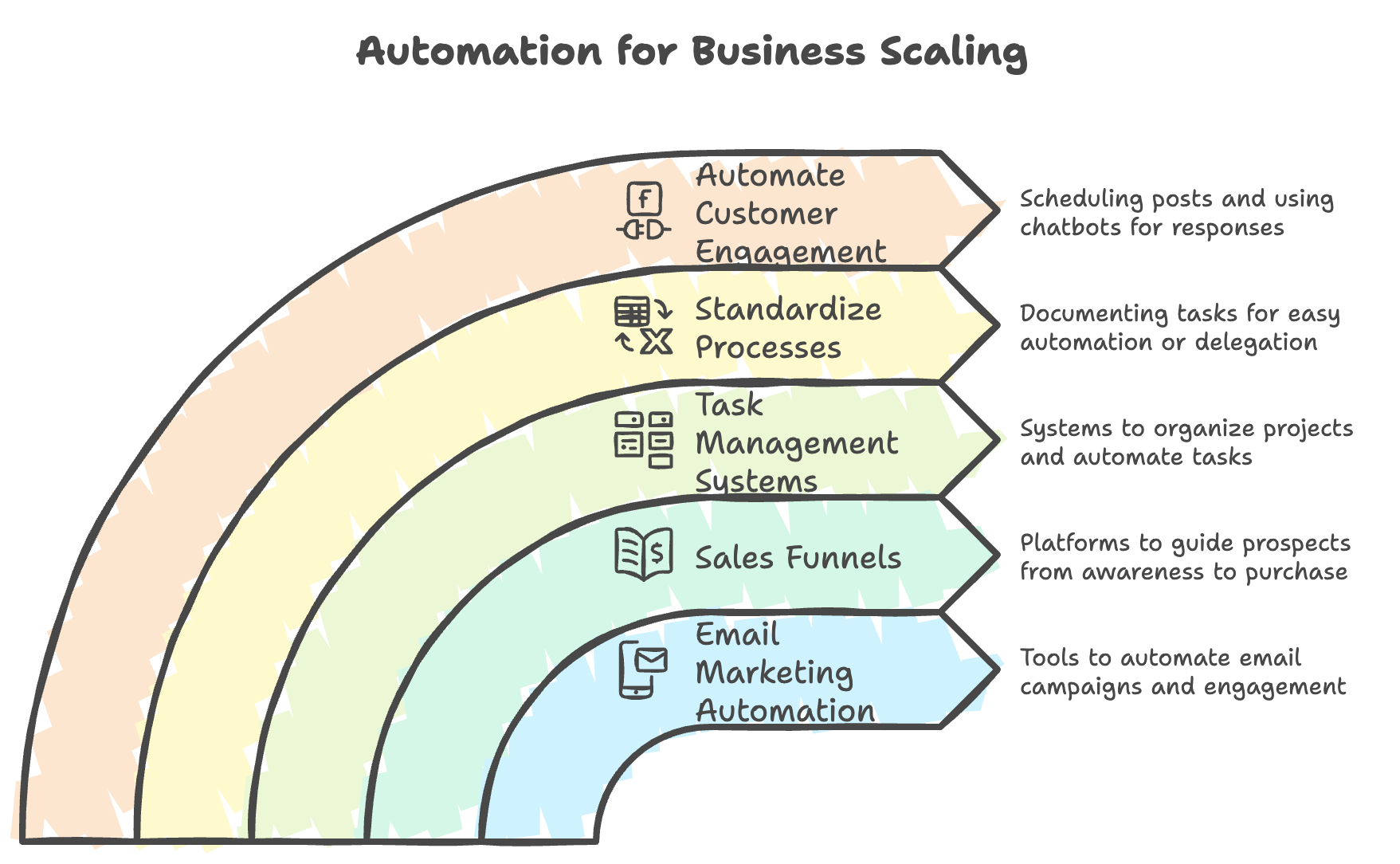
8.4. Expanding Offerings and Diversifying Revenue Streams
Once your primary product or service gains traction, consider expanding with complementary offerings or premium tiers to maximize revenue. Diversifying your income streams not only enhances stability but also creates multiple touchpoints for customer engagement.
Ways to Diversify Revenue Streams:
- Create Premium Tiers: Add a high-ticket option or advanced package with added value, such as one-on-one coaching or personalized guidance.
- Develop Complementary Products: Identify related products or services that enhance your core offering, like templates, e-books, or online courses.
- Membership or Subscription Model: Launch a membership or subscription service to provide ongoing value, building long-term loyalty and steady income.
Tips for Successful Expansion:
- Market Research: Survey your existing customers to identify additional needs they may have that align with your expertise.
- Launch with Early Access or Beta Groups: Introduce new offerings to a select group for feedback before a full launch.
- Monitor Performance: Track key metrics, such as conversion rates and customer retention, to assess the success of each new revenue stream.
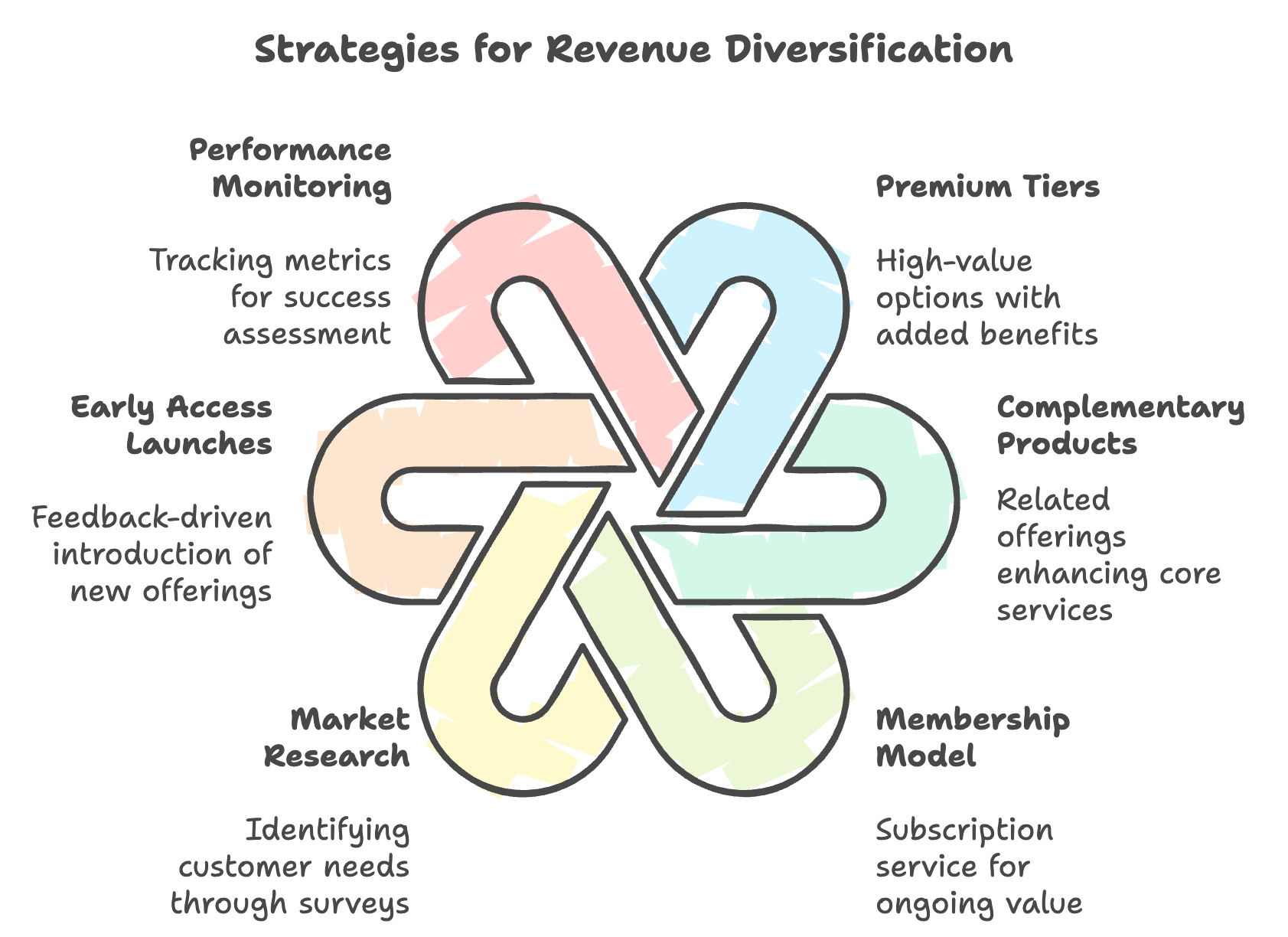
This structured approach to launching, automating, and expanding a digital business maximizes efficiency and long-term profitability. By strategically choosing a focus, gathering social proof, automating operations, and diversifying income, entrepreneurs can build a sustainable business with the potential for continuous growth.
9. FAQs: Common Questions About Building a $10k/Month Digital Business
How much time should I dedicate to my side hustle each week?
The time commitment depends on your goals, current workload, and the nature of your side hustle. Generally, setting aside 10-20 hours per week allows for steady progress without overloading yourself. Focus on high-impact activities, such as content creation, customer engagement, or product development, and consider time-blocking to maintain productivity.
What types of products or services work best for initial validation?
Low-cost digital products like e-books, templates, or guides are ideal for testing the waters. They’re quick to produce, easy to distribute, and offer a clear, accessible entry point for customers. These products allow you to gauge interest before investing heavily in more complex offerings. Service-based offerings, like consulting sessions, can also be effective as they provide one-on-one customer feedback.
How do I know if I’ve chosen the right niche?
A strong niche aligns with both market demand and your expertise. You’ll know you’re on the right track if:
- There’s a clear audience for your solution (validated through research or feedback).
- Your offer addresses a specific, pressing need for that audience.
- You feel confident and knowledgeable about the topic, allowing you to provide genuine value.
If you’re uncertain, try conducting a few small tests, such as posting relevant content on social media or running a survey, to gauge initial interest.
When is the right time to quit my full-time job?
Timing your transition from a full-time job to full-time entrepreneurship depends on financial stability and business momentum. Consider quitting when:
- Your side hustle generates a consistent, sustainable income that covers essential expenses.
- You have an emergency fund (usually 6-12 months of expenses) to handle any temporary fluctuations in income.
- You’re confident in your business model and have a clear growth plan.
Leaving your job too early can add financial stress, so ensure you have the necessary resources and traction before making the leap.
What’s the best way to find a mentor or join a mastermind group?
Mentorship and mastermind groups provide valuable guidance and accountability. To find a mentor, consider:
- Networking Events and Conferences: Industry events often provide opportunities to connect with experienced professionals.
- Online Communities: Join forums, LinkedIn groups, or specialized communities related to your field. Some established members may be open to mentoring relationships.
- Mastermind Programs: Paid mastermind groups, which bring together like-minded entrepreneurs, often offer structured guidance and resources.
Alternatively, seek mentors informally by reaching out to those you admire and offering value in return, such as help with a project or sharing your own expertise.
10. Conclusion: Framework Summary and Next Steps
10.1. Key Takeaways for Building a $10k/Month Digital Business
Embarking on the journey to build a $10k/month digital business requires a strategic, step-by-step approach that minimizes risk and maximizes potential. This framework emphasizes starting small, validating ideas, niching down, and scaling sustainably. Here are the core insights from the guide:
- Start Small with a Side Hustle: Maintaining a full-time job while beginning your digital business provides financial stability and the freedom to experiment without high pressure.
- Validate Before Scaling: By testing low-cost products or services initially, you can confirm demand, gain customer feedback, and avoid unnecessary financial risks.
- Shift from Input to Output Thinking: Focus on high-impact activities that drive results, and aim to create scalable assets that don’t require trading time for money.
- Niche Down for Targeted Growth: Serving a specific audience with a well-defined offer allows you to stand out and build a loyal customer base.
- Reinvest in Your Growth: Continuous learning, mentorship, and networking are essential for sustainable business growth.
- Leverage Digital Assets: Use repeatable assets like online courses, templates, and memberships to create passive income streams that scale with minimal additional labor.
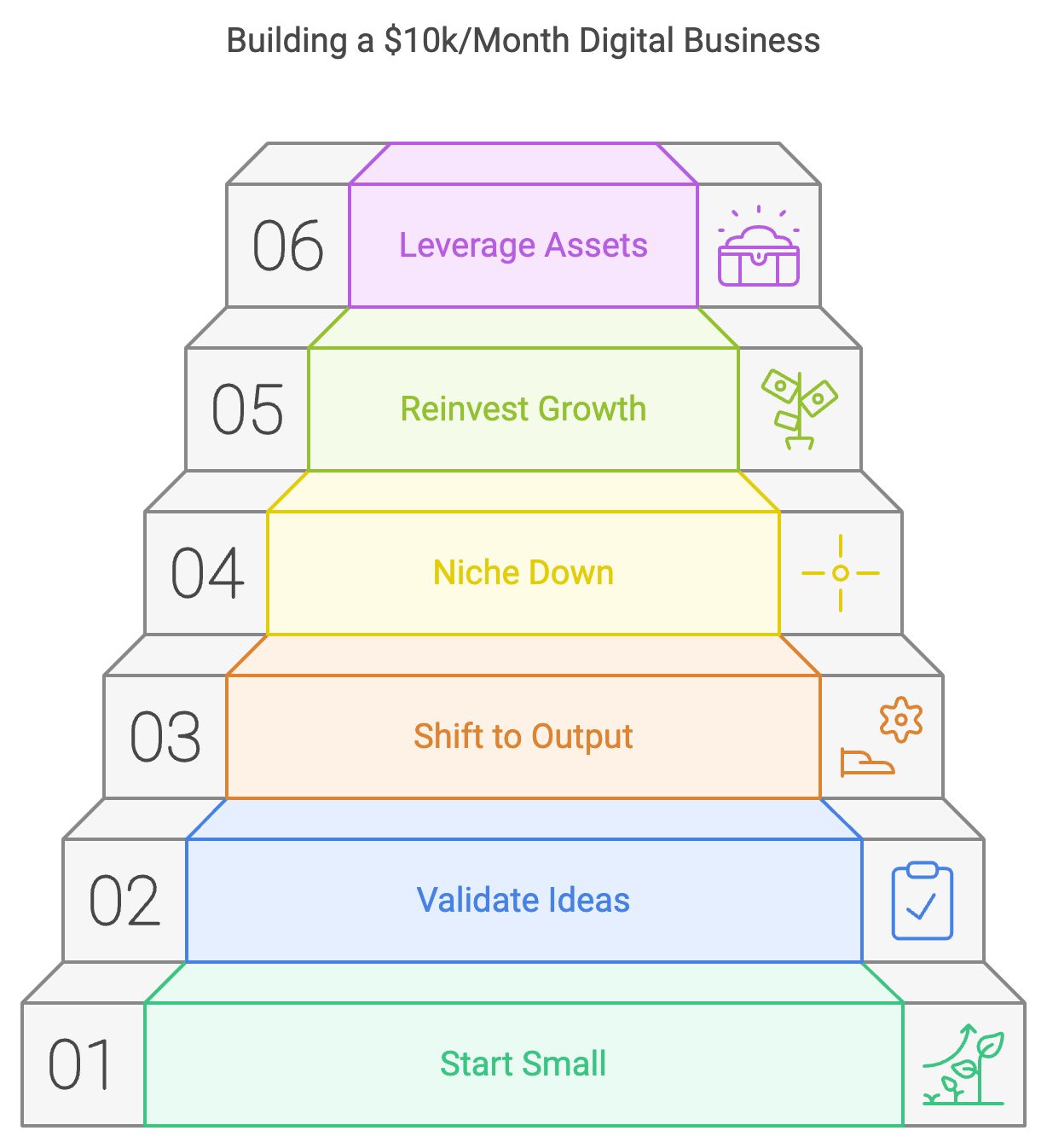
10.2. Steps to Take Immediately After Reading This Guide
Putting this framework into action requires commitment and consistent effort. Here are the next steps to help you launch and grow your digital business:
- Identify Your Skill or Interest Area: Consider your strengths and the market needs to choose a focus for your business.
- Conduct Market Research: Analyze competitors, define your target audience, and ensure there is demand for your chosen niche.
- Develop a Minimum Viable Product (MVP): Start with a simple, low-cost product or service that allows you to test interest without high investment.
- Set Up Feedback Loops: Engage with your audience, collect feedback, and use it to refine and improve your offer.
- Create a Consistent Schedule: Dedicate regular time each week to work on your business, balancing short-term tasks with long-term goals.
- Establish Automation Systems: As you gain traction, invest in tools that streamline operations, such as email marketing platforms and CRM systems.
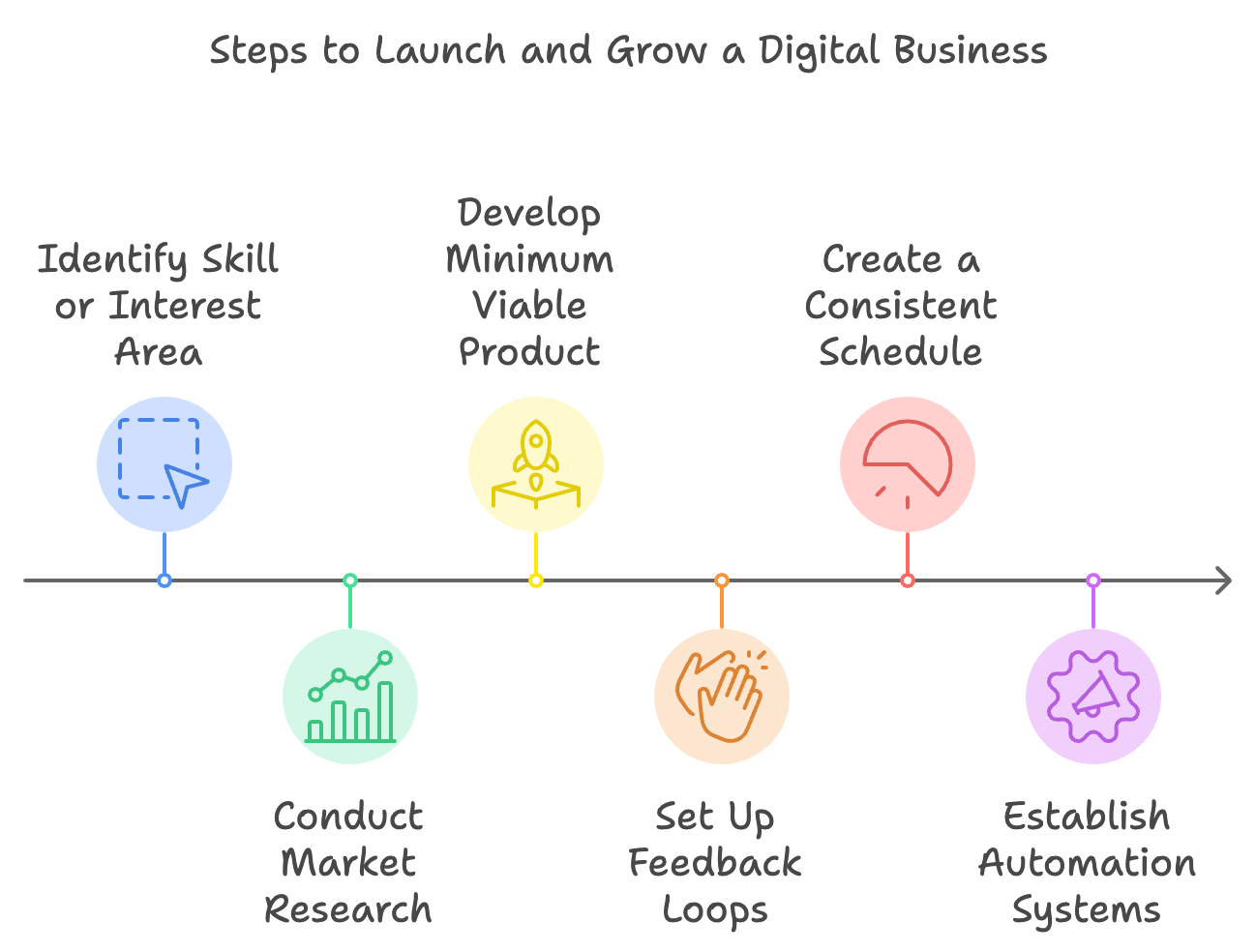
10.3. Encouragement and Final Thoughts on Achieving Success
Building a profitable digital business isn’t an overnight process, but with dedication, adaptability, and the right framework, you can create a sustainable income stream that grows with you. Remember, each step of this journey—from idea validation to reinvestment—is designed to position you for steady growth while minimizing financial and operational risks.
Stay focused on your unique value, engage meaningfully with your audience, and be open to continuous learning. The digital space offers vast opportunities, and by following this framework, you’re equipped with a strategic pathway to a
